Chapter 7: Visitor Attractions
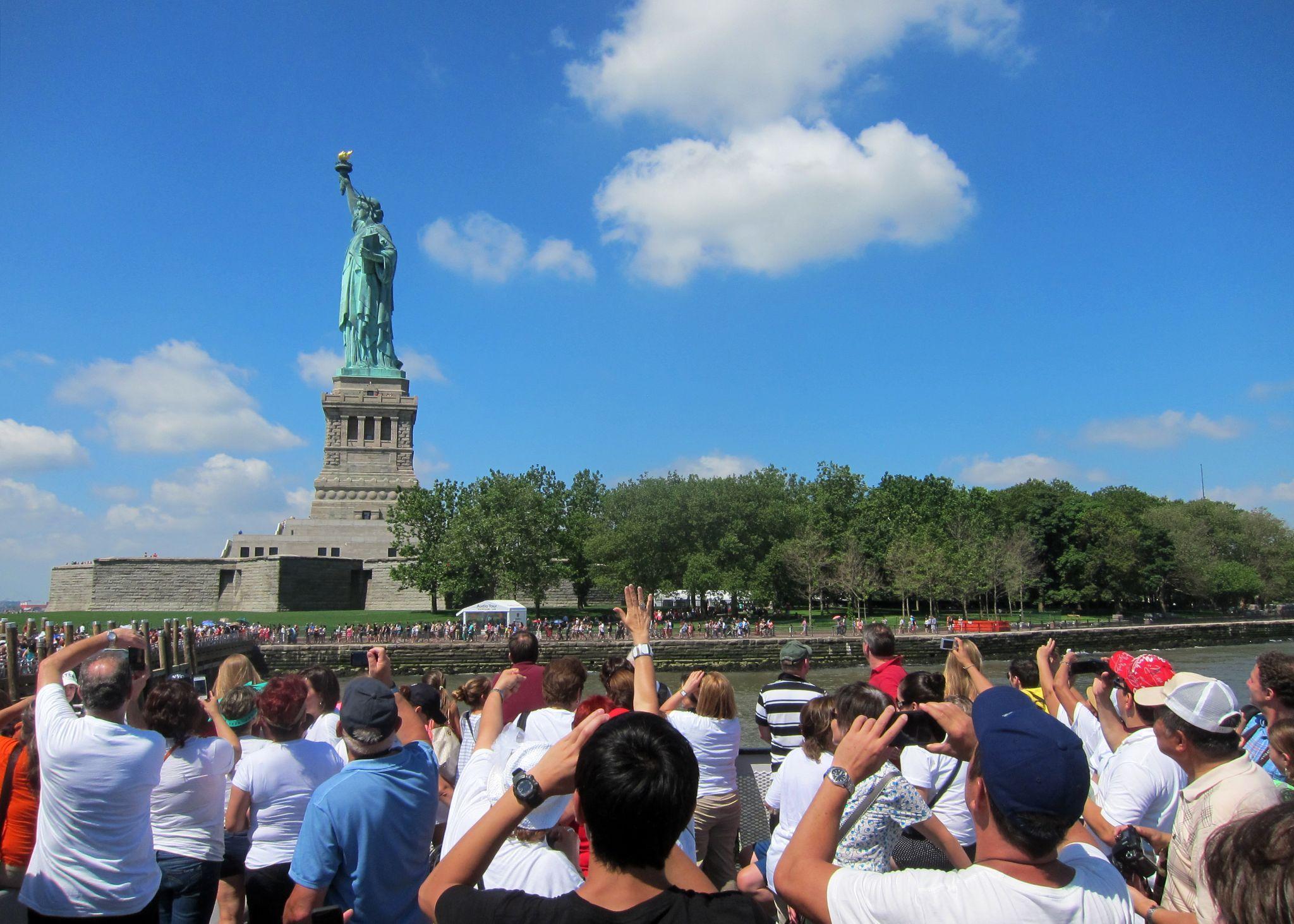
Overview
When you travel, do you exhaustively research the attractions at a destination and plan each step along your itinerary or do you plan to simply relax on a beach? While everyone experiences travel differently, visitor attractions are typically key elements to a tourist’s itinerary, contributing to a tourists’ decision to travel to a particular destination, and entertaining them while there. Attractions such as shopping, museums, zoos, historic and natural sites, amusement and theme parks, spas, and others also appeal to residents, and their proximity contributes to a resident’s quality of life and a location’s economic vitality. Places of interest make a place more interesting.
This chapter will discuss the role attractions play in tourism, touch on the commodification of sites, and explain the significance of visitor attractions in a broader scope. A few major attraction types will be analyzed in depth, including museums, zoos and aquariums, amusement and theme parks, and industrial attractions, and potential career paths at these types of attractions will be identified.
Objectives
- Learners will explain what the term ‘visitor attraction’ encompasses.
- Learners will identify the implications of commodifying certain sites as visitor attractions.
- Learners will describe the difference between demand generators and visitor amenities.
- Learners will summarize the history of visitor attractions.
- Learners will articulate the importance of attractions to a community and to tourism in general.
- Learners will compare and contrast the primary goals and operations of most museums, zoos, theme parks, and industrial attractions.
- Learners will identify possible career paths at visitor attractions.
Key Terms
- Visitor Attractions
- Day-Trippers
- Commodification
- Tourism Demand
- Demand Generators
- Visitor Amenities
- Taxonomy of Attractions
- Tourism Product
- Museums
- Not-for-Profit
- Research
- Conservation
- Public Exhibition
- Amusement Park
- Theme Park
- Agritourism
- Immersive
- Experiential
- Gamification
- Social and Ethical Awareness
- Accessibile Facilities
7.1 Introduction
7.1.1 What Is A Visitor Attraction?
The definition of a visitor or tourist attraction may seem straightforward, and most people may feel they can intrinsically identify one without a definition. Yet, there has been much debate academically on what constitutes a tourist or visitor attraction. Is a shopping center considered the attraction, or are individual stores considered attractions? Each individual store may not be the draw for the visitor, but collectively they become a place of attraction. If that shopping center was built to meet the needs of local residents, does not market to tourists, and is simply a functional place to purchase goods, can it fall into the category of a tourist or visitor attraction even if tourists do visit? If a place is not managed by an organization or company, like a scenic view for example, can that be considered an attraction? It would be attractive to visit, but how would it fit into the conversation around the tourist economy? Is the identification of attractions dependent on how the attraction is managed, if the attraction draws visitors to a destination, or by some other attribute?
This textbook will take the approach of generalizing the term to accept that anything that attracts tourists and is visited by tourists as a tourist/visitor attraction. Therefore, a tourist/visitor attraction can be any number of places, including a historic site, a building with beautiful architecture, a unique park, lake, or waterfall, a hiking trail, botanical gardens, theme parks, wildlife zoos, museums, art galleries, shopping centers, and more.
That said, in this chapter we are using the term “visitor attraction” instead of “tourist attraction” intentionally. That is because the broader term, “visitor” also includes residents who are not tourists. Many local residents enjoy visiting the same places that tourists enjoy visiting. Residents who visit attractions but do not stay overnight in accommodations in the destination are often labeled “day-trippers” , “same-day visitors” , or “excursionists” (United Nations World Tourism Organization, 2010).
A visitor attraction can be a festival like Burning Man, a large-scale arts event held annually in the desert in western U.S. It can be human-made, such as Mount Rushmore National Memorial in South Dakota with massive carved depictions of U.S. presidents on its cliff face, or natural, such as the Arches National Park in Utah, U.S. with over 2,000 natural stone arches. Nature in its pristine form, such as remote parts of the Amazon or northern Canadian tundras, can be visitor attractions. City centers, such as Paris or London, or active cultural centers, such as the pueblo villages of the Hopi that sit atop three towering mesas in Arizona, can be visitor attractions. Sites where popular movies were filmed can be visitor attractions, such as Skellig Michael, the island off the coast of Ireland where Star Wars: The Last Jedi (2017) was filmed. Visitor attractions can continuously emerge and evolve based on societal change and pop culture. They are as diverse as people’s interests.

Categorizing Attractions
DMOs, tourism boards, cities, and other organizations who need to strategically plan or manage visitor attractions often develop internal categorizations to organize and audit the visitor attractions located within their region.
The Canadian Tourism Commission (CTC), now Destination Canada, was formed in 1995 to plan, manage, and promote tourism for Canada. This organization, led by a volunteer Board of Directors representing all sectors of the tourism industry and from across Canada, set strategic priorities and plans for Canada’s approach to tourism promotion. With this industry-led input, the CTC identified five major categories of visitor attractions for Canada (Anderson & Westcott, 2021):
- Heritage attractions : focus on preserving and exhibiting objects, sites, and natural wonders of historical, cultural, and educational value (e.g., museums, art galleries, historic sites, botanical gardens, zoos, nature parks, conservation areas)
- Amusement/entertainment attractions : maintain and provide access to amusement or entertainment facilities (e.g., arcades; amusement, theme, and water parks)
- Recreational attractions : maintain and provide access to outdoor or indoor facilities where people can participate in sports and recreational activities (e.g., golf courses, skiing facilities, marinas, bowling centers)
- Commercial attractions : retail operations dealing in gifts, handcrafted goods, and souvenirs that actively market to tourists (e.g., craft stores listed in a tourist guide)
- Industrial attractions : deal mainly in agriculture, forestry, and manufacturing products that actively market to tourists (e.g., wineries, fish hatcheries, factories). (6.3 section, para. 3)
The above list is not an all-encompassing list of visitor attractions universally, but it meets the needs of the CTC. Other attractions not included in this categorization but widely accepted as visitor attractions are fairs, cultural festivals, performances, city centers in their own right (like Paris or London), and natural sites that are not managed (such as wild areas, beaches, or deserts).
7.1.1.1 Commodification of Sites
The term “attraction” can be perceived as callous in reference to some cultural or historic sites as it implies amusement and entertainment, when the nature of the place may be religiously and culturally sacred to groups of people or may be macabre in nature. It is uncomfortable to label the former Nazi concentration and death camp of Auschwitz, for example, an attraction, but for the fact that it attracted over 2 million visitors in 2019 (Auschwitz-Birkenau State Museum, 2020).
Developing a “visitor attraction” from a natural, historic, or cultural site has been referred to as the “commodification” of the site, or, in other words, turning the place and the story of that place into a commodity that can be bought and sold. Even if admission is free, gift shops, restaurants, tour guides, and other sold products add that element of capitalism.
This term is often used with negative connotations, referencing the dilution of cultural authenticity, the trivialization of difficult histories, or the imprisonment of natural places. Tourism development has led to all of those things, and developers focused on profit instead of sustainability and community engagement continue to capitalize on tourists’ eagerness to consume natural, historic, and cultural sites.
Tourism, and visitor attractions at its foundation, is integrated with social, political, environmental, and cultural issues. With changes in cultural systems and visitor influx, inherent struggles arise. Tourism development should be conducted with the local community at its core to minimize negative impacts and enhance the positive effects of developing attractions, which include site preservation, cultural preservation, job creation, economic vitality, education, and cultural understanding.
An example of how a community’s painful past experience has been exploited is with the Ninth Ward in New Orleans. In August of 2005, Hurricane Katrina, a Category 5 storm, devastated the city of New Orleans and surrounding areas, killing 1,833 people and causing nearly $108 billion in damages (National Weather Service, 2022). The Ninth Ward, in particular, experienced catastrophic flooding due to levee damage and storm surges. Shortly thereafter, approximately 30 tour companies began offering trips around the neighborhood. The tour operators began offering these tours in response to tourist demand, yet the residents of the Ninth Ward, the victims of this disaster, were not involved nor received compensation for the telling of their story (Slate, 2012).

As travel has become increasingly accessible and the growth of the tourism industry around the world rapidly spreads, native and marginalized people’s cultural traditions and heritage sites are becoming more and more commercialized. The question should be asked; who is making money from this? In addition, when a culture’s traditional and sacred places are shared with the public at large for commercial purposes, there is often little depth to the tourist experience which may perpetuate stereotypes and ignore deeper cultural nuances. And, with the influx of tourists, especially in reference to more isolated communities, the culture inevitably changes as youth often mimic the visitors’ cultural traits, such as western dress and technology.
Tourism can also have many positive impacts on culture and society. Tourism revenue can fund the preservation of heritage sites, revitalize customs and traditions, empower communities, and be a source of cultural pride. And, if done well, tourism can increase cross-cultural interactions and understanding between different cultural traditions.
In recent decades, some natural and cultural sites that were once available to tourists without restriction have been reevaluated with more cultural sensitivity. Uluru, a large sandstorm formation in central Australia, was once called Ayers Rock and attracted tourists who would ascend its side in streams like ants. Climbing this sacred rock, however, was disrespectful to the Aboriginal people who viewed Uluru as spiritually significant. Ascending the rock was banned by the board of the Uluru-Kata Tjuta National Park in 2017 out of respect for the religious views of the Aboriginal people (BBC, 2019).
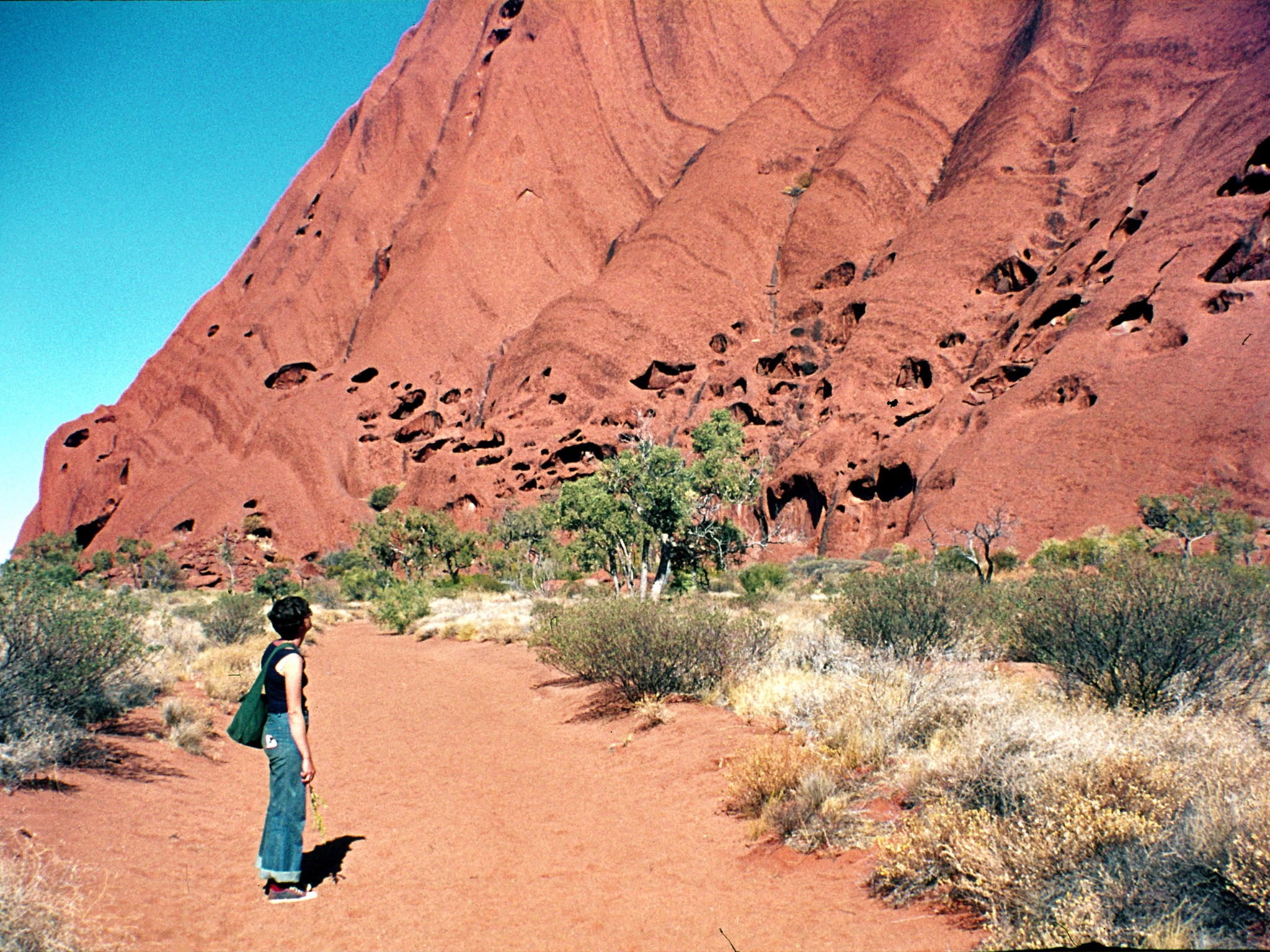
With the above examples in mind, one must approach certain attractions with cultural sensitivity and understanding. Visitors to museums and heritage sites should be aware that there may be more significant meaning behind the stories told about the objects and places on display. And informed tourists should realize that attractions are not always simply fun activities or interesting sites to see, but may also hold historically or culturally sensitive meaning.
7.1.1.2 Demand Generators vs. Visitor Amenities
As discussed in the previous chapter, increasing tourism demand is the goal of most of the marketing and sales campaigns generated by DMOs, the travel trade, and other tourism promoters. As a reminder, tourism demand is the number of people who actually purchase tourism products, such as rooms at hotels or seats on airplanes. Tourism demand can be generated through the promotion of certain attractions that draw interest from tourists.
Not all attractions are demand generators . If the attraction is unique to a place and of high interest to the traveling public, they can be the reason why tourists visit the destination. In other words, they drive demand to the destination. However, if an attraction is of lower interest to visitors, it is not something that will persuade them to visit the destination and is instead a visitor amenity . A tourist may partake in the activity or visit the attraction during their stay, but it is not the reason they traveled to the destination.
This section is using the terms ‘demand generator’ and ‘visitor amenity’ to describe in simplistic terms the roles of visitor attractions in the holistic tourism space. Both of these types of attractions are important. The demand generators are necessary to a healthy tourism economy as they shape the image of the destination and influence visitation. Visitor amenities are important to round out the tourist experience by providing a range of things for visitors to do while in the destination.
Identifying what attractions are demand generators is important to marketing a destination to tourists. However, doing so can be subjective because tourists are not homogeneous and their interests vary greatly. An attraction may be considered a demand driver for one segment of the population but not others. For example, the North Bend, Washington filming locations of the cult 1990s TV series, Twin Peaks, including Twede’s Cafe, is a demand generator for ardent fans, attracting thousands of visitors annually (Visit North Bend, n.d.). To non-fans, the cafe and other filming locations may be of mild interest and may be visited as time allows, but is not the reason for travel.
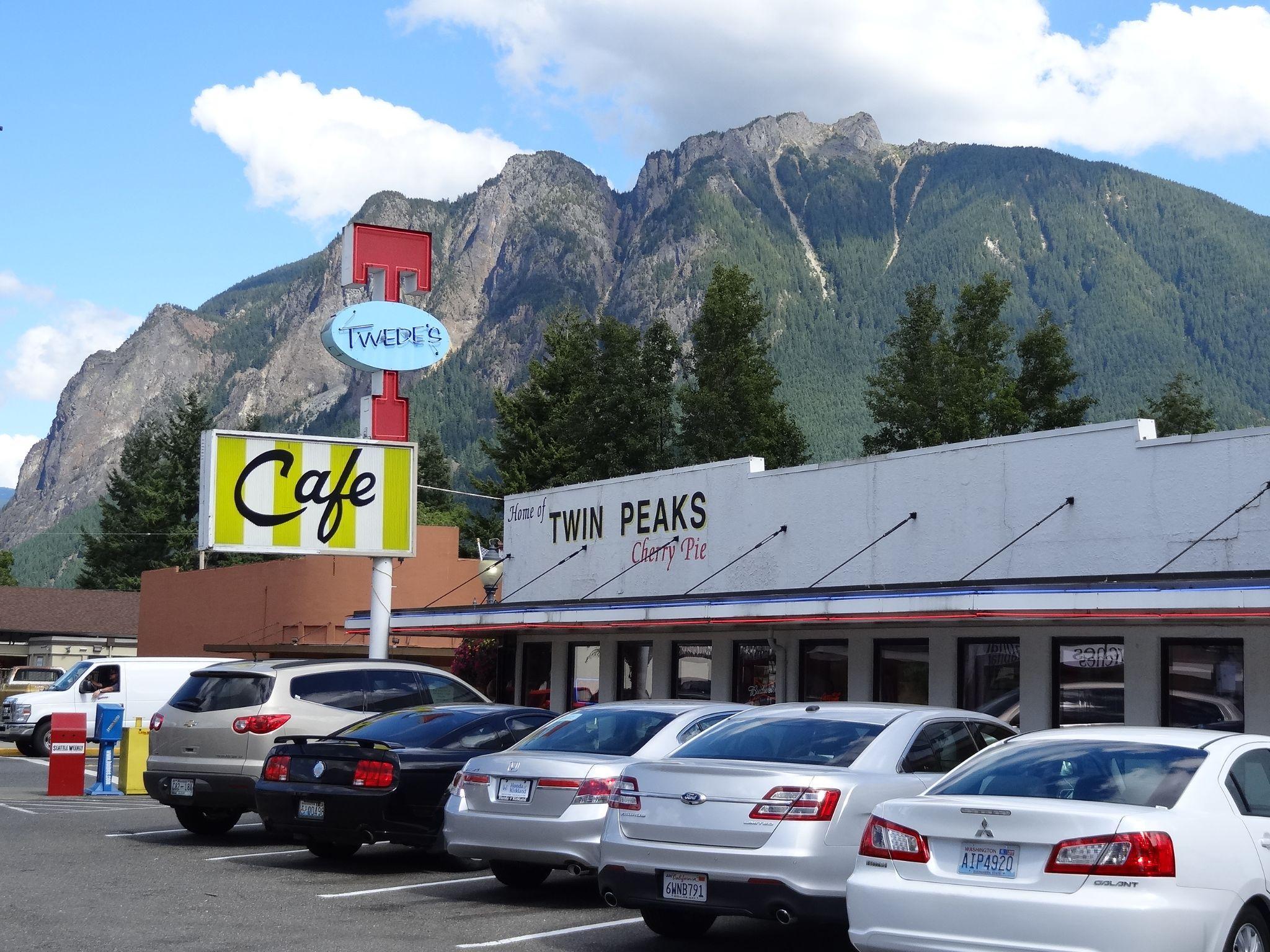
McKercher and Prideaux (2020) outlined a taxonomy of attractions that illustrates how individualized the motivations are to visit certain attractions. This classification system identifies the needs of the tourist (ie. the unique motivations for travel) at top and breaks out what types of attractions can satisfy that need. Progressing top to bottom, the identification of attractions that will meet the tourist’s needs becomes more specific. Below is an example of what a taxonomy of attractions may look like:
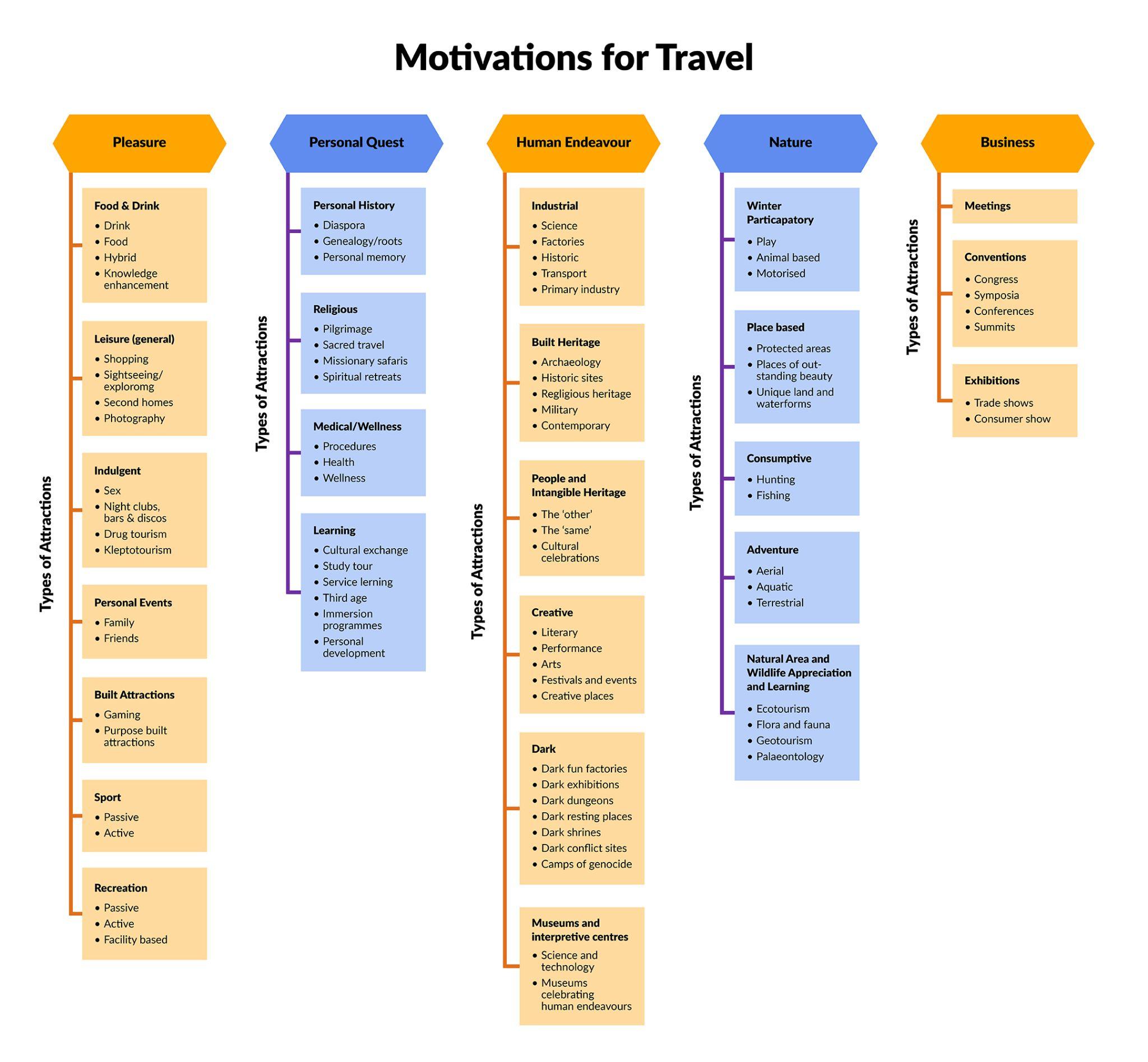
The more specific the needs of the traveler, the fewer attractions exist to satisfy those needs. For example, if someone is motivated to travel due to a personal quest to learn more about their genealogy, then a location relevant to their family history would be driving that visit. A more general need, such as the need to get away for relaxation, can be fulfilled by any number of attractions (beaches, pools, resorts, spas, etc.) at any number of destinations.
The needs and motivations of tourists are quite diverse. It is important for business plans, marketing plans, and tourism development plans to distinguish between what people do in a destination and why they come. Most DMOs, tour operators, and other organizations that promote destinations will focus on the more wide-reaching and general needs of tourists so that their marketing efforts highlight more universally appealing attractions that will attract the interest of a more general audience. However, it is worthwhile to also recognize the specific attractions that will appeal to a more niche audience, especially if that attraction is unique to a destination and therefore would be advantageous in the competitive tourism marketing space.
7.1.2 History of Visitor Attractions
The history of visitor attractions is as old as the history of tourism itself. As explained in [crossref:1]Chapter 1[/crossref], early motivations for travel were often focused on visitor attractions with holy, intellectual, or cultural significance. Religious pilgrimage to Mecca or Jerusselum, grand tours of Europe to experience art and culture, and travel to the British seaside focused on visiting the attractions in those destinations: the religious and city centers, the museums, and the resorts.
Humans have a long history of collecting and displaying things as a means of attracting visitors. A museum dating from the 6th century B.C.E. was discovered during the 1925 archaeological excavation of the city of Ur in Mesopotamia (Museums of the World, n.d.). Holy relics, which are bones or objects associated with a saint or holy person, have been acquired and displayed in reliquaries for centuries, attracting Christian pilgrims to cathedrals, monasteries, and other religious sites across Christendom, from Rome to the Holy Land. Ancient Greeks and Romans filled their temples with artwork for display. And kings displayed the spoils of war in the halls of their royal palaces. Many also enjoyed keeping wild animals. In fact, the earliest known menagerie dates back to 2500 B.C.E. in Egypt, where rulers attempted to show their power and influence by keeping elephants, hippos, baboons, and various species of large cats.
The personal collection of Elias Ashmole, which included antique coins, books, and geological and zoological specimens, opened to the public in 1683 in the University of Oxford and is considered one of the first public museums (Alexander et al., 2010). The Louvre in Paris, France in 1793 during the French Revolution, displaying French royal collections to the general public for the first time. Charles Willson Peale’s Cabinet of Curiosities in Philadelphia opened in 1786 and was one of America’s first museums, displaying his own portraits of historical figures, bones of a North American wooly mammoth, and other art and artifacts that documented the history of the new world.

The model of the modern, public museum, as well as zoological parks, emerged in the 18th century during the Age of Enlightenment. This was a period in European history when a range of societal values were centered on the development and promotion of science, reason, and logic, which carried over to heighten the importance of taxonomical based displays. Zoological displays, as well, became more focused on research and science instead of simply curiosity. Since the 1980s, zoos began to focus on replicating natural habitat and conservation sanctuaries to advance the research and reproductive potential.
Other attractions emerged in the 19th Century with the rise of leisure time and disposable income in the United States, including amusement parks and arcades. Some of the first amusement parks in the United States were established on Coney Island, including Sea Lion Park, which opened in 1895 and “pioneered the concept of charging admission to an enclosed park” (Sullivan, 2015, para. 16); Luna Park, which replaced Sea Lion Park in 1905; Steeplechase Park; and Dreamland. All of these parks had a unique character and competed with each other for visitors, offering rides, shows, carnival games, sideshow acts, daredevil acts, elephants, and even people from remote places, such as Inuit people (referred to as “Eskimos” at the time).

As for the first theme park, both Knott’s Berry Farm and Holiday World claim the title. Knott’s Berry Farm originated in the 1920s as a roadside fruit stand in Buena Park, California. They soon added a very popular tea room so famous for its fried chicken that guests would wait up to three hours for a table (Ellis, 2020). In the 1940s, the Knotts family, in an effort to entertain patrons, began building a ghost town replica which over the years expanded into the western themed park it is today.

In 1946, Santa Claus Land opened in Santa Claus, Indiana. The park, leveraging the town’s unique name, offered an alpine village, toy shop, children’s rides, and a daily appearance from St. Nick. The park has expanded over the years to include additional holidays such as Halloween, Thanksgiving, and 4th of July and subsequently changed its name to Holiday World (Yesterday’s America, n.d.).
The concept of the themed, immersive park was undoubtedly pioneered by Walt Disney in the 1950s with the opening of Disneyland in Anaheim, California. Disney took amusement park ideas to new levels by extensively theming different “lands” around storytelling themes, decor, music, costumes, rides, shows, foods and overall atmospherics (Yesterday’s America, n.d.). Walt Disney did his research. He visited many amusement parks around the country to learn what made them successful. Disneyland aimed to transport guests into fantastical, fully-realized worlds and its success catalyzed a new generation of similarly ambitious theme parks.
Walt Disney World Resort opened in 1971 in Lake Buena Vista, Florida, significantly expanding on Disneyland’s concepts with multiple themed parks, resort hotels, and dining and entertainment complexes. Other corporations like Universal and SeaWorld began building elaborate theme park destinations in Orlando, often competing directly with Disney World. Countless smaller amusement parks, theme parks, family entertainment centers, and more appeared across the country.
Another popular theme park, Six Flags Over Texas, opened in Arlington, Texas, in 1961, and focused each of the six sections of the park on a different country that governed Texas at one time, including France, Spain, Mexico, the Confederacy, the United States, and Texas itself (Yesterday’s America, n.d.). Visitors paid a single admission price to enter and enjoy the rides that reflected Texas’s unique heritage. Today, Six Flags operates 30 parks in North America and more amusement parks around the world.
Theme parks continuously evolve based on pop culture. For instance, Universal Studios opened The Wizarding World of Harry Potter in the 2000s, capitalizing on the popularity of the books and films among Millennials who grew up with the series. Theme parks based on brands like Star Wars, Nintendo and others similarly leverage intellectual property to draw fans. In order to remain relevant to patrons, park elements constantly evolve with consumer tastes, technology and trends.
7.1.3 Significance of Visitor Attractions
Visitor attractions are a critical component to what makes a location a tourist destination. In previous chapters, we reviewed the concept of tourism products ([crossref:4]Chapters 4[/crossref] and [crossref:5]5[/crossref]), which are the elements of travel tourists purchase or experience. Visitor attractions are essential tourism products because they are what draws tourists to a location and can contribute significantly to visitors’ overall experience in a destination. In addition, when a DMO, tour operator, or travel blogger puts together a marketing campaign, tour itinerary, or article, they typically frame their approach around the visitor attractions within the destination. These attractions are the central element of a destination and make up the appeal, ambience, and experience of a location. Visitor attractions are vital to a healthy tourism economy.
McKercher and Prideaux (2020) argue that tourism is driven by the inter-related presence of attractions along with access to those attractions. Without attractions, there is little to no reason for someone to travel to a location, little necessity to improve access, and little need for other tourism services and goods. However, access to a destination and tourism services will expand with the presence of attractions. Without the attractions or access to those attractions, the destination’s tourism industry is not likely to thrive.
Visitor attractions are significant in other ways as well. Heritage attractions especially, including museums and art galleries, preserve and exhibit objects of significance, allowing for the public sharing of objects that may, in other circumstances, be held in private collections. Historic sites are preserved from destruction and educate the public on the historical and cultural significance of a place. Zoos and botanical gardens preserve and display life for public appreciation, conservation, and inspiration. And nature parks and conservation areas preserve the land for wildlife habitat and public use. Industrial attractions, like manufacturing facilities, can educate and enlighten visitors while also entertaining them. Even theme parks, such as Disney’s EPCOT Center, can teach visitors about human achievements through its focus on celebrating technological innovation and international culture. Even those who do not seek out education for the sake of learning can find that they are learning while also being entertained.
7.2 Today’s Visitor Attractions
With such a broad range of attraction types, it is difficult to include in this textbook a discussion of all possible attractions that may be of interest to visitors. Therefore, this chapter will detail some of the most popular types of visitor attractions that provide the most wide-spread career opportunities.
7.2.1 Museums
Museums focus on preserving and exhibiting significant natural or human-made places, animals, or objects and using those exhibits or stories to educate the visiting public. 76% of all U.S. leisure travelers participate in heritage activities such as touring museums when visiting a destination (American Alliance of Museums [AAM], 2022).
According to the International Council of Museums (Icom)’s 2022 definition, “A museum is a not-for-profit, permanent institution in the service of society that researches, collects, conserves, interprets and exhibits tangible and intangible heritage” (as cited in Adams, 2022, para. 4).
Below are some examples of different types of museums (Lee, 2024):
Open-Air Archaeological Sites : archaeological sites that are open for visitation, such as the Tusayan Ruins located inside Grand Canyon National Park pictured below.
Art Museum s: galleries that display art objects such as paintings, photography, sculpture, etc.
Historic Homes : a house of historic significance that is preserved and usually restored to a particular time period.
History Museum : a collection of historically significant objects.
Living History Museums : a place where actors perform historical events or perform tasks typical to a time period.
Natural History Museums : a museum that houses preserved bones or bodies of animals and/or plants, such as dinosaurs.
Science Museums : a center that displays scientific concepts, usually interactive.
Zoos and Aquariums : establishments that maintain a collection of living animals.
It is important to note that the above definition specifically calls out that a museum “is a not-for-profit ” entity and that its purpose is “in service to society.” Not-for-profit means that the organization’s primary mission is not to earn a profit. The term “museum” may be used by the general public or in marketing materials by enterprises that are for-profit whose purpose is to make money. These businesses are not focused on conservation, research, or education and cannot be considered true museums. Ripley’s Believe it or Not, for example, encourages people to “visit any one of Ripley’s 29 museums around the world to marvel at hundreds of unusual artifacts and get hands on with amazing interactives” (Ripley’s, 2019, para. 1). While they do exhibit historic or unusual natural and human-made artifacts, they are not primarily in the business of using these artifacts as tools to educate the public as much as they are interested in admission sales. They are therefore not in service to society and can instead be considered an entertainment business.
Fact

At the Met Gala in 2022, Kim Kardashian famously wore the dress that Marilyn Monroe wore in 1962 to sing “Happy Birthday” for President John F. Kennedy. This caused an uproar amongst archivists and historians who felt that the dress was of such historical significance that it should have been kept in a controlled environment, free of exposure to the elements and safe from accidental damage. Critics accused Kardashian and Ripley’s Believe it or Not (the owners of the dress) of recklessness for desecrating a historic object. However, neither Kardashian or Ripley’s did anything technically wrong. Ripley’s purchased the dress legally at auction in 2016 for $4.8 million (Schwedel, 2022). And, as a privately held, for-profit entertainment company, they do not play by the same rules as museums. Museums are held to standards of ethics, set by the institution and based on industry standards, that would not allow for dresses or other objects to be loaned out in such a careless manner. Because a museum is run in service to society, it would prioritize conservation and preservation over the marketing that Ripley’s and Kardashian surely anticipated from such actions (Clary, 2022).
Grand Canyon National Park Tusayan Ruins Tour
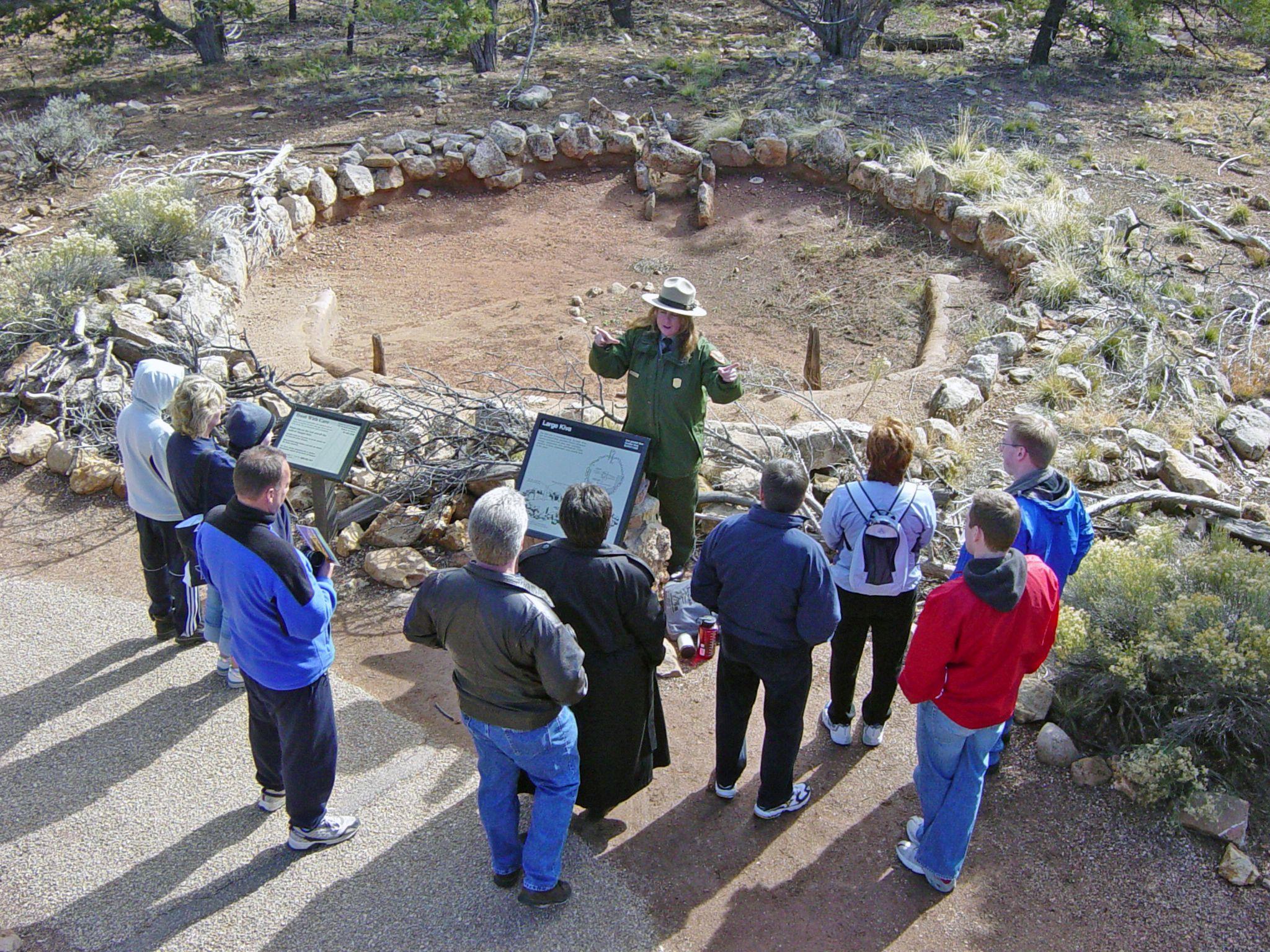
Museums are more than just collections of objects. They are institutions that preserve articles of significance for posterity and for use as tools to educate the public. Because of this, museums are bodies of institutional knowledge and learning. The American Alliance of Museums (AAM) declares that museums have the power “to create learning environments that inspire our curiosity, challenge our thinking, and help us develop greater empathy and understanding” (AAM & Wilkening Consulting, 2021, p. 2). As leaders in their communities around the world, many museum administrators are asking themselves, “how can our museums play a leading role in combating hate and disinformation in such a divided nation?” (p. 2).
Icom’s definition of a museum (above) continues below in its entirety:
“Open to the public, accessible and inclusive, museums foster diversity and sustainability. They operate and communicate ethically, professionally and with the participation of communities, offering varied experiences for education, enjoyment, reflection and knowledge sharing” (as cited in Adams, 2022, para. 4).
This definition was only adopted in 2022 after three years of heated debate amongst Icom’s membership, leading to several resignations among the council’s board and committees, and the stepping down of its former president. The reason this definition holds such importance is because it formally emphasizes the social leadership many museum administrators feel they are responsible for within their community in “social justice, global equality and planetary wellbeing” (International Council of Museums, 2019, para. 5).
About Patrice
Patrice McGahee-Bell, Director of Guest Service and External Affairs at the Northwest African American Museum (NAAM) in Seattle, Washington, found her passion for working in a museum after trying out various roles, including sales, marketing, and event planning (personal communication, May 10, 2021).
“It is exciting to work at a museum, particularly one that caters to the African-American community. It is important to preserve and share the often untold history of black people in the Pacific Northwest.”
The museum, housed in the historic Coleman School built in 1909, plays a vital role in archiving and showcasing this history. In addition, NAAM’s mission is focused on educating and entertaining visitors through events, talks, partnerships, and art exhibitions.
“The main gallery, Paccar gallery, and Legacy gallery, each serve a unique purpose in promoting education and engagement.”
Due to the impact of COVID-19, NAAM closed its doors to the public in March 2020. McGahee-Bell and the NAAM staff adapted by offering virtual programming, partnership opportunities, and community engagement activities. The reopening on Martin Luther King Jr. Day, 2023, celebrated King with youth activities, food trucks, music, civil rights film screenings, and exhibits highlighting local artists.
In terms of her responsibilities, McGahee-Bell oversees programming, marketing, public relations, and the museum store. She took the opportunity to reshape the museum store, leveraging her marketing knowledge to design and introduce new merchandise. Under her leadership, store sales increased significantly in the first three months.
McGahee-Bell is passionate about managing relationships, especially in the non-profit sector, with donors, partners, and community support. Positive relationships, such as collaborations with the Seattle Opera, support the museum’s mission to “spread knowledge, understanding, and enjoyment of the histories, arts, and cultures of people of African descent for the enrichment of all.”
Looking ahead, McGahee-Bell hopes to continue the virtual experiences developed during the Covid pandemic and reach a broader audience. She feels it is important to stay connected with professional organizations, attend conferences, and participate in niche groups related to museum management.
For individuals interested in a non-profit events career, McGahee-Bell recommends tying oneself to a mission rather than a specific organization. She emphasizes the value of volunteering in areas aligned with one’s passions and skills, providing practical experience and networking opportunities.
About Patrice McGahee-Bell
L. Patrice Bell comes from an operations and program planning and controls background. Her experiences span aerospace, nonprofits, hotels, museums, and tech startups.
A native Oklahoman, Patrice is a graduate of the Atlanta University Center Dual Degree Engineering Program. She completed her Bachelor of Science in Mathematics at Spelman College (Atlanta, GA) and her Bachelor of Science in Industrial & Management Engineering at Rensselaer Polytechnic Institute (Troy, NY). Although her educational background is technical, her passions are rooted in human connection and experience. This passion led her to complete an A.A.S. in Hospitality & Tourism Management at Highline College (Des Moines, WA). The goal for everything she does is to leave it better for those who will come after her. She is always working to create sustainability and longevity. There is a beautiful intersection of industrial engineering and hospitality, and she is moving full steam ahead to exist in that nexus.

As explained above, museums are by definition non-profit. This is by design so that the integrity of the institution is withheld and the focus is not on the commercialization of heritage objects and stories or on making a profit. However, being a non-profit organization does not preclude museums from pursuits that generate revenue through ticket sales, private event rentals, food and beverage, souvenir sales, and donations. To maintain operations, museums must generate revenue to pay for staff, programs, and maintenance.
Museums in the United States use a variety of sources to support their operations. These include governmental grants , private donations , earned revenue , and investment income . This mix of revenue is dependent on national and global economic conditions, especially with philanthropic giving, which makes museums highly volatile and budget sensitive.
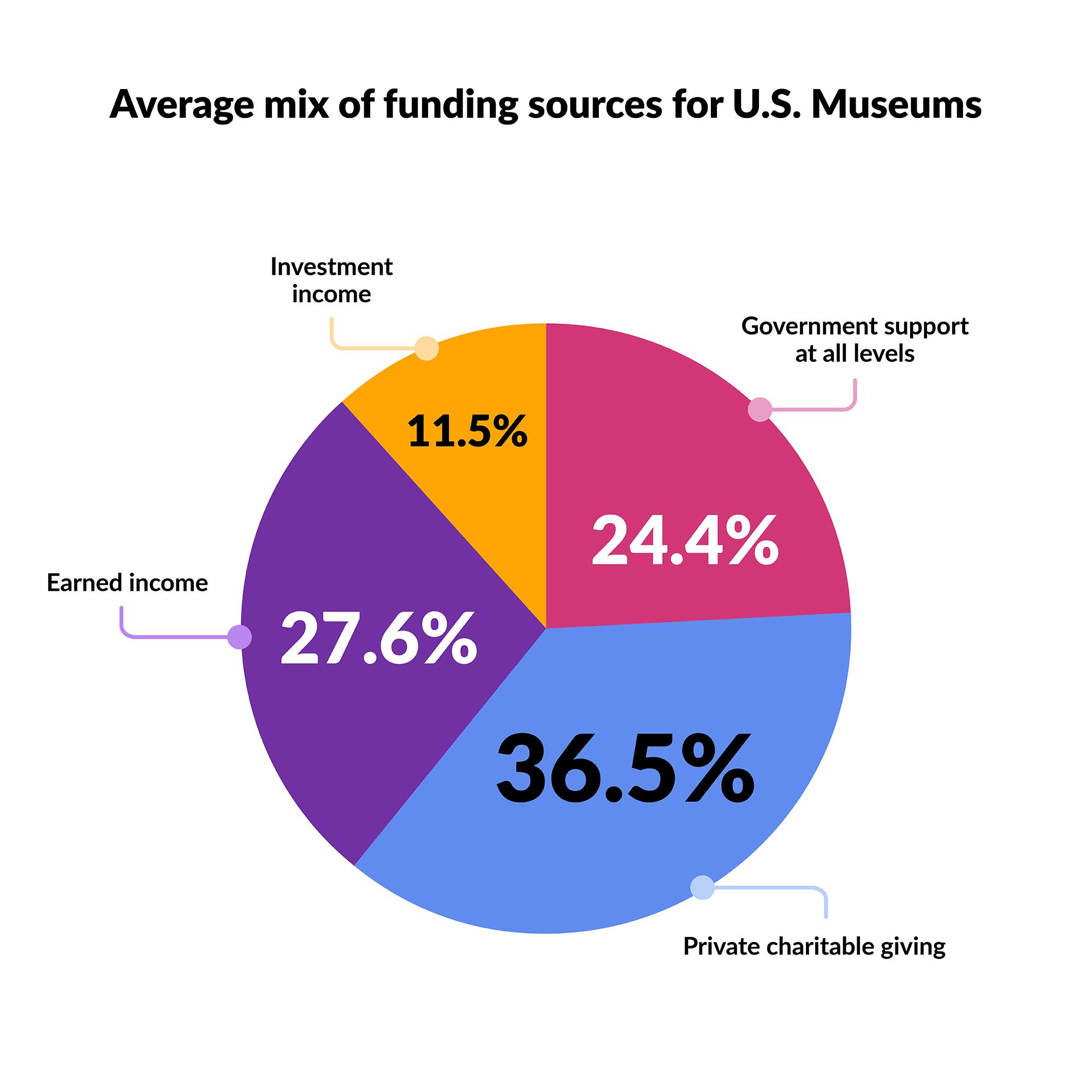
This funding makeup is important to understand because there are career opportunities behind each one of these revenue streams. Grant writers are often employed by museums to obtain federal, state, and local government grants. Development departments solicit donations from private donors and corporations, organize fundraising galas, and promote Giving Tuesday (the Tuesday after Thanksgiving), year-end giving (the tax savings deadline for the year for donors), and will bequests (a donation granted through a will). Earned income is generated from admission fees, store sales, private event rental, and food and beverage operations, all of which offer a career pathway. Lastly, investment income comes from endowments, or gifted funds that are set aside in an investment account to generate future income and require investment management to maximize revenue (Bell, 2016).
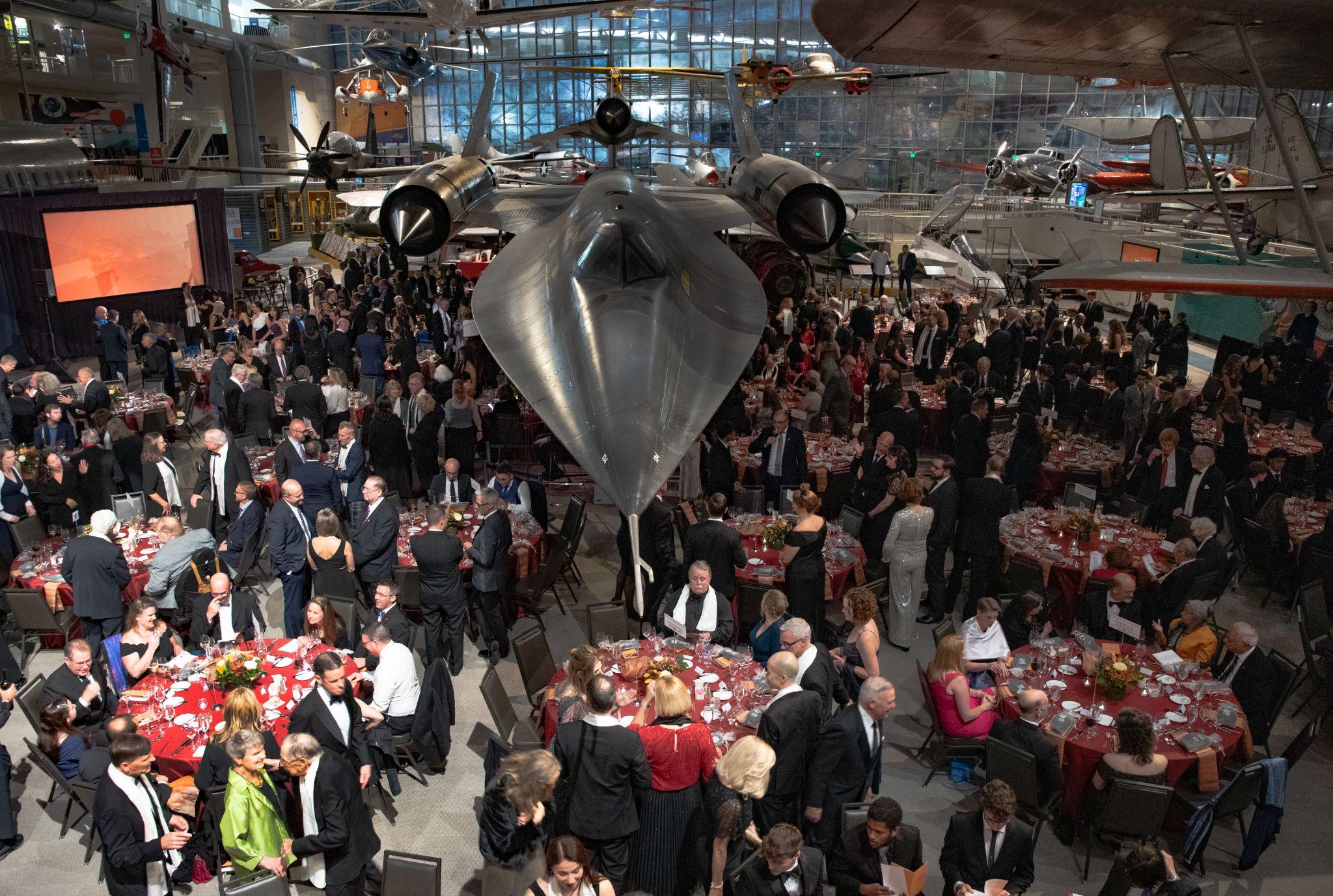
Fact
Interestingly, admission fees only account for a worldwide average of about 5% of museum’s revenue, and 37% of museums do not charge an admission fee at all. These museums find that, without an admission fee, more revenue can be generated through other concessions like food and beverage, special tours, additional experiences, and gift store sales (AAM, 2022).
The Museum of Flight (2023) near Seattle, Washington operates on a nearly 23 million dollar budget, made up of mostly admission and retail sales and donations.

The Covid pandemic forced many museums, cultural institutions, and other public heritage sites to close to the public. Museums were especially hard hit, with 90% closing their physical doors during the height of the pandemic and as many as 1 in 8 possibly never reopening (Kasiola & Metaxas, 2023). However, the communal importance of these institutions fueled museum staff to adapt and use their ingenuity to continue to share art, history, and culture with patrons virtually. Louisiana’s Old State Capital developed a virtual field trip, complete with interactive coloring and design projects and even a virtual puzzle, to allow students an opportunity to engage while attending school from home. Baton Rouge Gallery Center for Contemporary Art developed The Flat Curve Gallery to encourage artists, and emerging artistic youth, to produce art related to staying home to “flatten the curve” (referring to Covid cases graph). Online streaming events, like sessions with artists and an online auction and fundraiser further engaged the community. Nothing can replace the in-person, hands-on experience of a museum, however, this adaptation has opened people’s eyes to sharable possibilities. More virtual programs allow for increased longevity and accessibility of content and participants can experience the museum from all over the world and at any time.
7.2.2 Zoos & Aquariums
Zoos’ and aquarium’s living collections make them unique types of museums with their own unique concerns.
Zoos and aquariums are facilities in which animals are housed in enclosures for research , conservation , and public exhibition . The roles of zoos and aquariums generally fit within the following four pillars: conservation, education, research, and recreation. Zoos and aquariums provide a unique opportunity for urban residents and tourists alike to see and experience the wonders of nature on land and under the sea. In addition, zoos and aquariums can make substantial contributions to environmental education and habitat preservation .
As of March 2024, there are currently more than 235 zoos and aquariums in the U.S. accredited by the Association of Zoos and Aquariums (AZA) (n.d.-a). AZA is the independent accrediting organization for the best zoos and aquariums in the world. Accreditation from the AZA assures the public that the zoos and aquariums they are visiting “meet the highest standards for animal care and welfare” (para. 1). About 200 million people visit AZA-accredited zoos and aquariums each year, a figure that surpasses the combined annual attendance rates of the major professional sports leagues, such as the NFL, NBA, NHL, and MLB (AZA, n.d.-a, 2023).
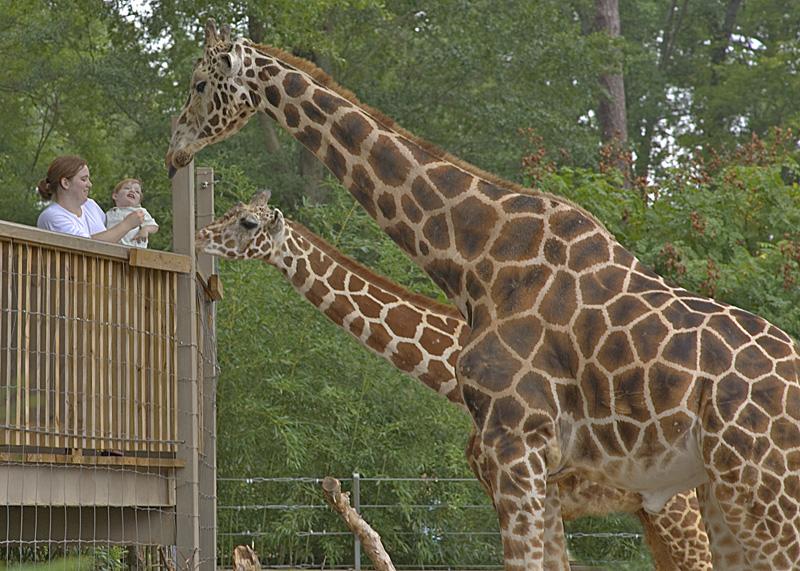
Much like museums that house inanimate objects, zoos and aquariums are leaders in public education and conservation. For example, the Monterey Bay Aquarium, the second largest aquarium in the U.S. located in Monterey Bay, California, is actively working to coordinate science, policy, and communication efforts focused on four key areas: Pacific Ocean wildlife and ecosystems, global fisheries and aquaculture, plastic pollution and climate change and ocean acidification (Monterey Bay Aquarium, n.d.). In fact, they are a popular resource for the public to turn to for sustainable seafood recommendations. Their Seafood Watch program identifies what seafood is more environmentally responsible based on scientific information. These recommendations are then used by the public to make better choices for their own health and the health of the ocean.
AZA-accredited zoos and aquariums have collaborated on breeding and reintroduction programs responsible for saving numerous species. Several notable examples include: California condors, black-footed ferrets, Przewalski’s horse, Ohio River Basin Freshwater Mussels, golden lion tamarins, and American red wolves. AZA-accredited zoos and aquariums spend an average of $230 million on field conservation projects that support more than 800 species (AZA, n.d.-a).
There are two primary ways that modern zoos support conservation of wild animals:
- Ex-situ programs , which involve management actions in captive settings (e.g., captive breeding programs)
- In-situ programs , which entail actions in the species’ natural habitat (e.g., animal reintroductions or supporting anti-poaching operations in a national park).
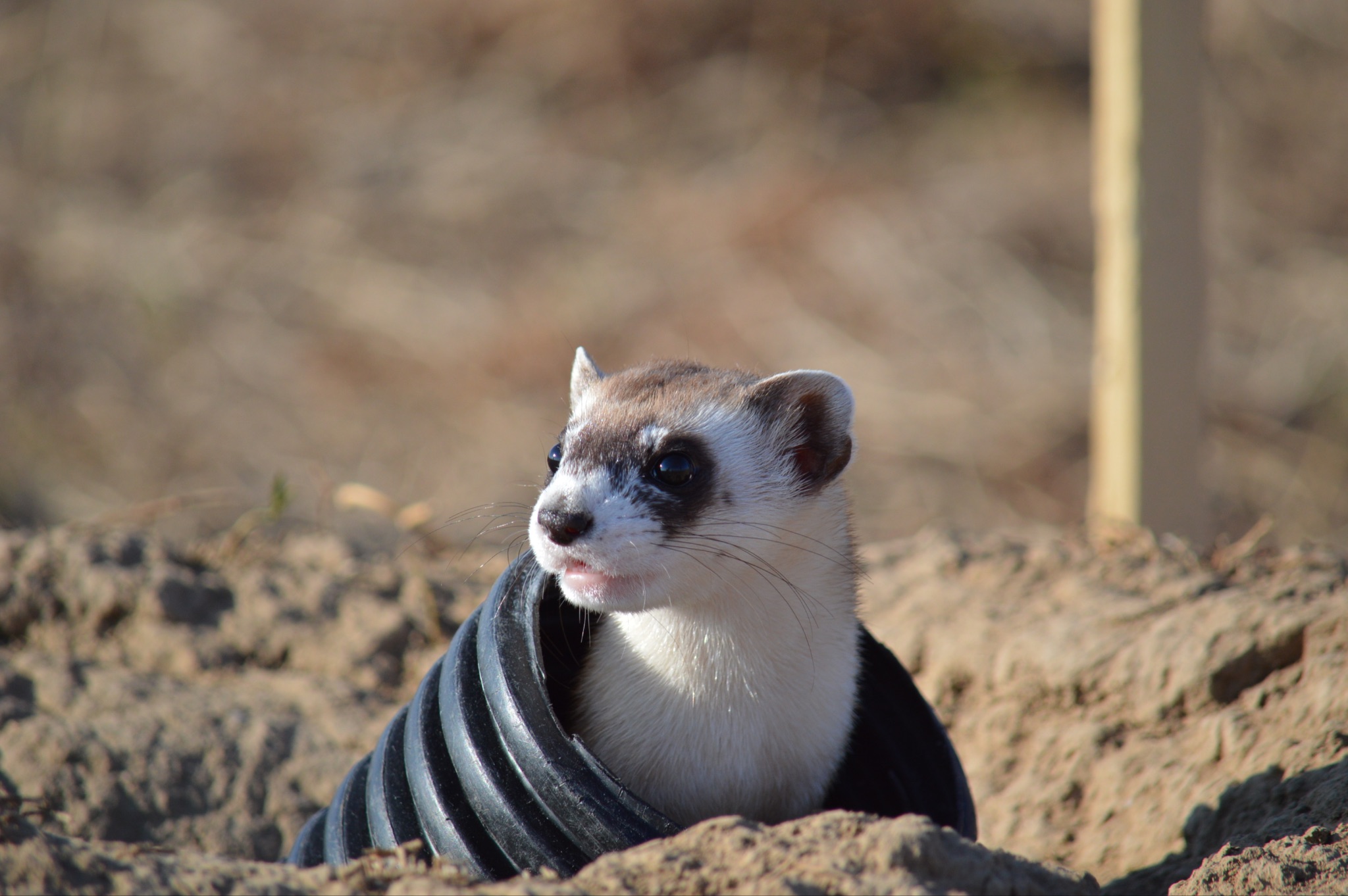
San Diego Zoo
With visitation regularly surpassing the 4 million mark, the San Diego Zoo is the most visited zoo in the US. Spanning 100 acres of land leased from the City of San Diego, the facility houses 4,000 animals representing more than 650 species (San Diego Zoo Wildlife Alliance, 2024). The zoo’s affiliate organization, San Diego Zoo Wildlife Alliance, is a private nonprofit organization with one of the largest zoological membership associations in the world.

The San Diego Zoo also operates the San Diego Zoo Safari Park, an expansive 2,000-acre park that features animals in more spacious, open settings compared to the zoo’s more urban 100 acres. Exhibits are mostly centered on the theme of habitats from Asia, Africa, and Australia.
Taking advantage of its pleasant year-round climate, the San Diego Zoo pioneered open-air, cageless exhibits that feature more natural animal habitats. As part of a visitation package, the zoo offers a guided bus tour that traverses the grounds. Known as the Skyfari, there is also an overhead gondola lift that provides an aerial view of the zoo.
Some have argued that zoos and aquariums are morally objectionable, caging creatures in relatively small, unnatural spaces for the entirety of their lives for entertainment purposes. The argument is not without merit, as there are many zoos and aquariums not guided by AZA standards of conservation, education, and research. Even AZA-accredited facilities have been accused of not successfully fulfilling these mandates. Very few zoos or aquariums, for example, commit more than 5% of their operating budget to conservation. One notable exception is the Wildlife Conservation Society – based at the Bronx Zoo in New York – which dedicates nearly 25% of its total annual budget to conservation (Miller et al., 2004).
In addition, interviewed zoo visitors did not express an increased sense of environmental responsibility upon exiting zoos than they had before entering (Clayton et al., 2011). In practice, people typically do not go to zoos to learn about environmental concerns. They go to be entertained, to see interesting animals, and to spend time with their children, family, and friends. Despite this criticism, seeing animals in person is a more intimate and memorable experience than seeing animals in photographs or on television, and inherently fosters affinity, understanding, and empathy toward animals.

Zoos and aquariums are some of the most popular visitor attractions for a destination. More than just places of entertainment and collections of creatures, zoos and aquariums allow visitors to see land and sea animals rarely witnessed in their natural habitats. In addition, many are institutions of knowledge and research, while simultaneously publicizing important issues that affect the habitats and health of humans and animals alike.
7.2.3 Amusement and Theme Parks
Unlike museums, amusement parks and theme parks are offered as pure fun, although sometimes educational components are also incorporated. Amusement parks typically offer rides and games and are stationary, differentiating them from carnivals or fairs that are more mobile. Theme parks are amusement parks that have a central theme, such as the wild west, the animal world, movies, etc., represented in the structures, types or rides and games, and in their marketing and branding materials.
DIsney’s Animal Kingdom is a zoological theme park in Orlando, Florida, U.S. While one of the most popular theme parks, it is also AZA-accredited, indicating that it has met established standards in education, conservation, and research. The park’s purpose and design reflects an effort to maximize animal welfare with a focus on environmental responsibility. For example, unlike with other Disney parks, no nighttime firework shows take place at Disney’s Animal Kingdom. No plastic straws or balloons are allowed. Conservation and breeding programs are a major focus of the park. And, while entertaining over 9 million visitors in 2022, messaging educates the public on issues of environmental habitat loss (Statista Research Department, 2023b).
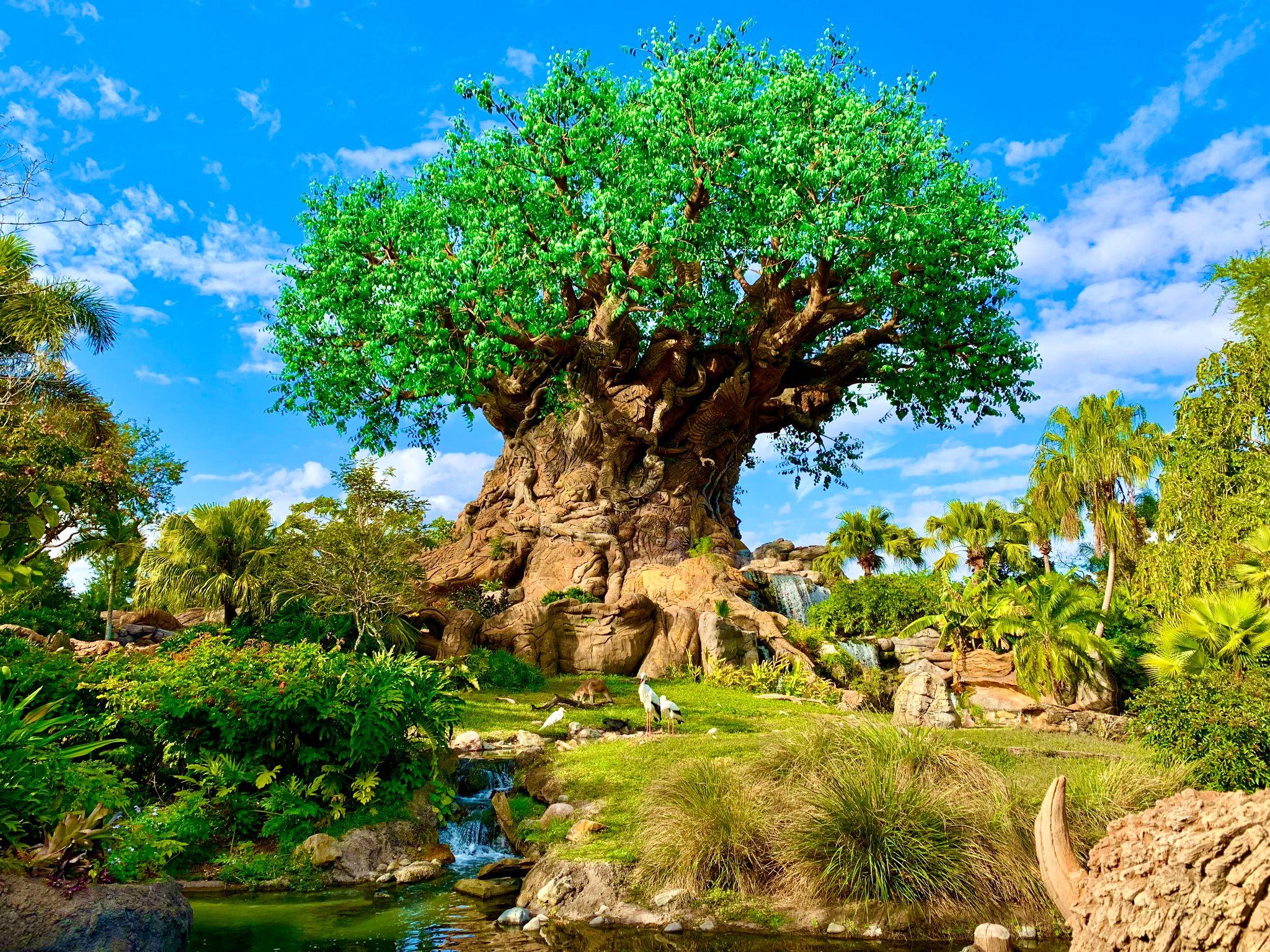
While each type of amusement and theme park has unique characteristics, they share some commonalities. They provide experiences and activities outside of everyday life. They aim to be fun, entertaining, and sometimes educational. Visitors immerse themselves in themed environments and partake in rides, shows, exhibits, games, tours, and other attractions. The parks appeal to diverse market segments, from families to couples to corporate groups. They generate billions in annual revenue and attract hundreds of millions of visitors globally each year.
The following table lists the most popular amusement and theme parks worldwide and their attendance (in millions) from 2019 to 2022.
|
Name of Park |
2019 |
2020 |
2021 |
2022 |
|
Magic Kingdom (Walt Disney World), USA |
20.96 |
6.94 |
12.69 |
17.13 |
|
Disneyland Anaheim, USA |
18.66 |
3.67 |
8.57 |
16.88 |
|
Universal Studios, Japan |
14.5 |
4.9 |
5.5 |
12.35 |
|
Tokyo Disneyland, Japan |
17.91 |
4.16 |
6.3 |
12 |
|
Islands of Adventure, USA |
10.38 |
3.64 |
9.08 |
11.03 |
|
Disney’s Hollywood Studios, USA |
11.48 |
3.68 |
8.59 |
10.9 |
|
Universal Studios Orlando, USA |
10.92 |
3.91 |
8.99 |
10.75 |
|
Tokyo DisneySea, Japan |
14.65 |
3.4 |
5.8 |
10.1 |
|
Epcot (Walt Disney World), USA |
12.44 |
4.04 |
7.75 |
10 |
|
Disneyland Park, France |
9.74 |
2.62 |
3.5 |
9.93 |
|
Disney’s Animal Kingdom, USA |
13.89 |
4.17 |
7.19 |
9.02 |
|
Disney’s California Adventure, USA |
9.86 |
1.92 |
4.98 |
9 |
|
Universal Studios Hollywood, USA |
9.15 |
1.7 |
5.5 |
8.4 |
(Statista Research Department, 2023a).
A list of the most visited amusement and theme parks with Walt Disney’s Magic Kingdom topping the list (20.96 million visitors).
|
|
|
|
Most visited amusement and theme parks worldwide |
2019 |
|
Magic Kingdom (Walt Disney World), USA |
20.96m |
|
Disneyland Anaheim, USA |
18.66m |
|
Tokyo Disneyland, Japan |
17.91m |
|
Tokyo DisneySea, Japan |
14.65m |
|
Universal Studios, Japan |
14.50m |
|
Disney’s Animal Kingdom, USA |
13.89m |
|
Epcot (Walt Disney World), USA |
12.44m |
|
Chimelong Ocean Kingdom, China |
11.74m |
|
Disney’s Hollywood Studios, USA |
11.48m |
|
Shanghai Disneyland, China |
11.21m |
|
Universal Studios Orlando, USA |
10.92m |
|
Islands of Adventure, USA |
10.38m |
|
Disney’s California Adventure, USA |
9.86m |
|
Disneyland Park, France |
9.74m |
|
Universal Studios Hollywood, USA |
9.15m |
|
Everland, South Korea |
6.61m |
|
Lotte World, South Korea |
5.95m |
|
Nagashima Spa Land, Japan |
5.95m |
|
Europa-Park, Germany |
5.75m |
|
Hong Kong Disneyland, Hong Kong S.A.R. |
5.70m |
|
Ocean Park, Hong Kong S.A.R. |
5.70m |
|
Efteling Theme Park Resort, the Netherlands |
5.26m |
|
Walt Disney Studios Park, France |
5.25m |
|
OCT Happy Valley, Beijing, China |
5.16m |
|
Chimelong Paradise, China |
4.91m |
(Statista Research Department, 2023a).
The Covid pandemic temporarily shut down or reduced attendance at many amusement and theme parks. The U.S. Census Bureau reports that amusement and theme park estimated revenue dropped 63% in 2020 compared to 2019, from $20.1 billion to $7.4 billion (Villarreal, 2024). Disney Parks implemented an attendance cap of 20% below pre-pandemic levels, which remained in effect through 2023 in response to increased guest satisfaction (WDWMagic, 2023).

The U.S. theme park industry is highly concentrated among a few major players. Currently, the Walt Disney Parks and Resorts parks division earned $7.9 billion in operating profit in 2022 (Kelleher, 2023) with its 12 worldwide theme parks, 6 of which are located in the U.S. at 2 campuses, one in California and one in Florida:
- Disneyland Resort (California)
- Disneyland
- Disney California Adventure
- Walt Disney World Resort (Florida)
- Magic Kingdom
- EPCOT
- Disney’s Hollywood Studios
- Disney’s Animal Kingdom
- Tokyo Disney Resort
- Tokyo Disneyland
- Tokyo DisneySea
- Disneyland Paris
- Disneyland Park
- Walt Disney Studios Park
- Hong Kong Disneyland
- Hong Kong Disneyland Park
- Shanghai Disney Resort
- Shanghai Disneyland
Universal Studios operates 4 theme parks in the U.S., including 3 in Florida (Universal Studios Florida, Islands of Adventure, and Volcano Bay) and 1 in California (Universal Studios Hollywood).
SeaWorld Parks and Entertainment operates 12 theme and water parks focused heavily on animal exhibits, shows and education. Their largest park, SeaWorld Orlando, draws around 4 million annually (Sylt, 2018). SeaWorld faced backlash over animal rights issues following the 2013 documentary Blackfish, forcing a repositioning to emphasize education, research and conservation.
Beyond these heavyweights, Six Flags operates over 25 amusement parks across North America. Cedar Fair owns 13 amusement parks including Cedar Point and Knott’s Berry Farm. Other major amusement park chains include Palace Entertainment and Parques Reunidos, which combined operate over 50 parks worldwide.

Modern theme parks incorporate state-of-the-art rides, interactive games and shows, digital media, expanded food options from snacks to meals with characters like Mickey Mouse, unique special events like wine festivals and holiday parades, higher-end dining and dessert parties, private VIP tours, and options to skip lines through services like Disney’s Genie+ service or Universal Express . Technologies like RFID (radio-frequency identification) wristbands track guest behavior to tailor offerings via apps and email. Guests can reserve ride times, order food pickup, and more. And, this technology enables operators to analyze traffic patterns to better distribute crowds, boosting visitor satisfaction and spending.
7.2.4 Industrial Attractions
An industrial attraction is a manufacturing site, agricultural site, or other operation that invites visitors to tour behind-the-scenes and watch the production process. Examples of industrial attractions include factories, mines, wineries, fish hatcheries, and farms or plantations. The factory, farm, or other industrial operation is the primary purpose of the company and the majority of employees are focused on producing the industrial product. However, other dedicated staff focus on marketing to tourists and providing visitors with interesting experiences. These companies have found that they can generate revenue, expand the reach of their brand, and educate visitors by inviting them to tour their facility and watch how their industrial process works.
Industrial attractions have been steadily rising in popularity in recent years, especially with farm tours, also known as agritourism . With declining profitability in farm operations, many farm owners have begun to invite visitors to participate in farming practices, such as picking berries or harvesting pumpkins. Wineries offer tours of their vineyards or meals served amongst rows of grapes. Traditional farms offer encounters with animals, petting zoos, hay rides, farm-to-table dining, and more. Farms involved in agritourism sometimes offer farm stays where guests are invited to stay on farm property. Horse or cattle ranches offer opportunities for visitors to interact with horses. These activities provide income from entrance fees as well as direct sales from agricultural products. Agritourism income grew by 67% over the 10 years between 2007 and 2017 (U.S. Department of Agriculture [USDA], 2022), and by 2022, 28,617 farms in the U.S. have offered agritourism and recreational services (USDA, 2024).
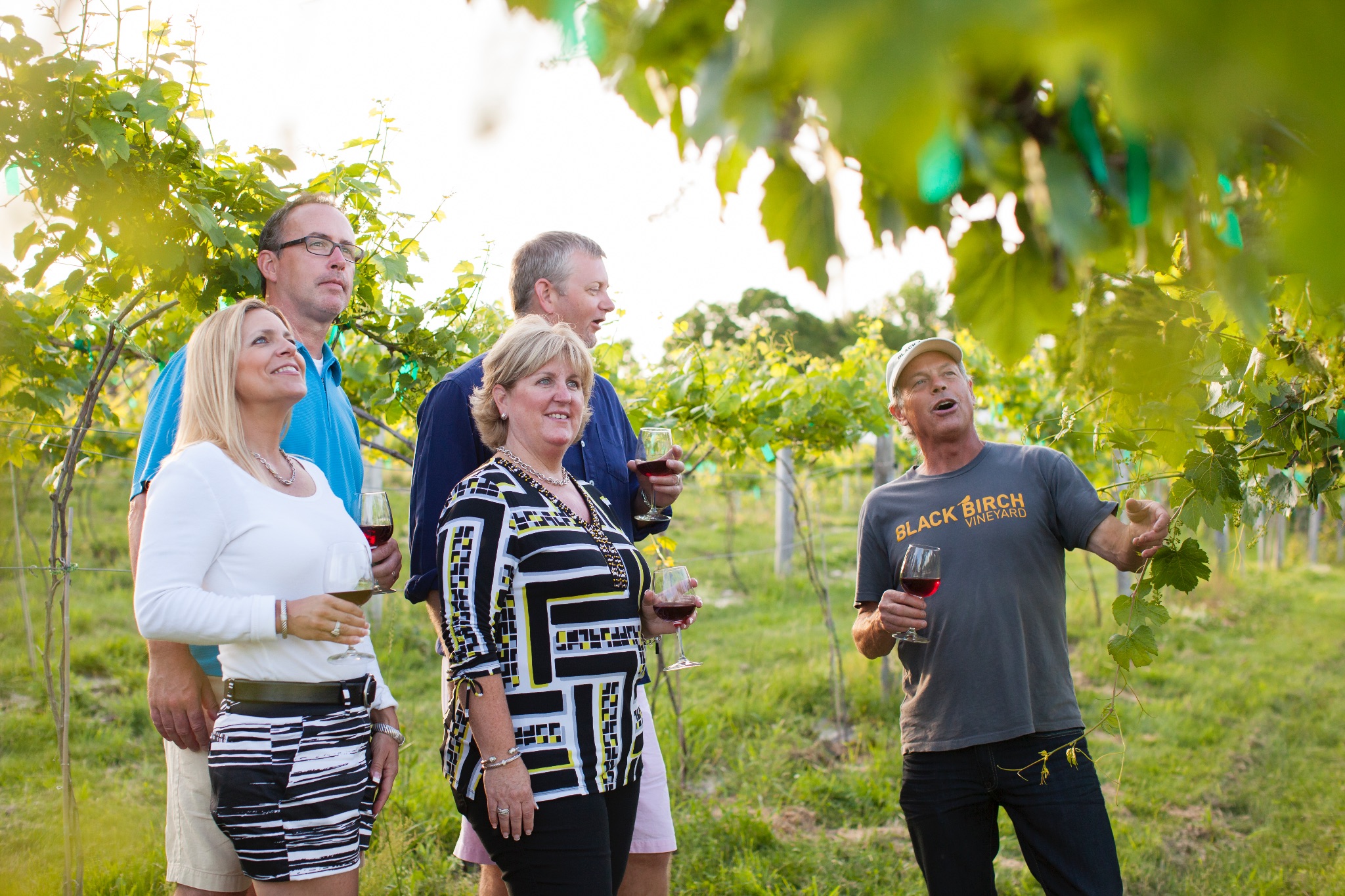
Manufacturing tours are also popular, especially with famous brands such as Microsoft or Nike that sell specific products that visitors use. The Boeing airplane factory, for example, is a very popular visitor attraction in Everett, Washington, attracting over 6 million visitors from around the world since it opened in 1968 (Perrella, 2023). Opening factories to the public for tours can earn additional revenue for a company as well as help reinforce brand loyalty. Visitors get to see the behind-the-scenes production process, which can educate and elevate public perception of a product.
About Jean Thompson, CEO Seattle Chocolate
With an unparalleled love of chocolate, Jean Thompson has led Seattle Chocolate Company as owner and CEO since 2001 in the Seattle area producing high quality, sustainable chocolate bars and truffles in colorful packaging (personal communication, December 20, 2023). Her passion runs deeper than simply the food product. She is an advocate for sustainable harvesting practices of cacao beans and a champion for elevating the chocolate industry as a whole.

The chocolate industry faces many challenges in relation to the production of the cacao beans that are made into chocolate. Cacao farmers are impoverished, the rainforest is being destroyed in an attempt to increase yield, and demand for chocolate is outpacing supply. Thompson advocates for chocolate to be viewed as an artisan product like fine wine to increase its value and improve the lives of cacao farmers.
“I opened my factory at Seattle Chocolate for tours because I want to bring people in and educate them about chocolate and to understand the journey of a cocoa bean from the farm where it is grown to the finished chocolate bar on your local grocery store shelf. I believe this is the first step to appreciate chocolate as both delicious and nutritious, and appreciated for its rich layers of flavor and nuance based on terroir, fermentation, and roasting as well as fun flavors.”
The Seattle Chocolate factory in Tukwila, Washington invites visitors to learn how chocolate is made. This is paired with chocolate tastings where guides emphasize chocolate’s complexity and flavor nuances. Visitors are taken into the manufacturing facility to see the “chocolate-making machines and the start-to-finish creation of [their] truffles and bars from the vantage point of our hot pink walkway, raised nearly 10 feet high” (Seattle Chocolate, n.d., para. 10). The company also hosts community events such as wine and chocolate pairings and a career day for high school girls to learn about jobs in the chocolate industry. Each October, the company hosts a family-friendly Haunted Chocolate Factory where guests brave the darkened factory searching for clues to solve a mystery and are rewarded with chocolate.
The Nisqually Earthquake in 2001 left the young and struggling Seattle Chocolate Company in ruins. As an early investor with a strong tech marketing background, Jean Thompson took over the daily operations of the company as owner and CEO (personal communication, December 20, 2023). Her determination, willingness to learn and adapt, and curiosity fueled her throughout the nine years that it took to turn the company around. Seattle Chocolate truffles bars and truffles are now sold in all 50 states and Canada.
In 2012, Jean launched jcoco chocolate, a culinary inspired chocolate line with a built-in give back. With both brands, Jean hopes to elevate the chocolate industry as a whole through innovative flavor combinations and consumer education. Jean is also using the popularity of chocolate to empower customers to make a difference: jcoco donates 10% net profits to cocoa farmers and Seattle Chocolate donates 10% net profits to support girls and women.
In December 2019, Jean delivered a TEDx talk entitled “Imagine a World Without Chocolate” sharing her vision of a chocolate renaissance. Jean was named to Inc.’s 2022 100 Female Founders list and serves as vice president of the Fine Chocolate Industry Association (FCIA) board. Jean has always been passionate about doing the right thing when it comes to business practices. In 2022 Jean led the charge for the entire company to become carbon neutral and earned the City of Tukwila’s Recycler of the Year in 2023.

7.3 Careers in Visitor Attractions
Provided above is an introduction to some of the most popular types of visitor attractions. These companies offer a wide range of employment opportunities with some career paths highly specialized, like curator at a museum or zookeeper at a zoo, and some career paths that cross over into other types of visitor attractions, such as grant writers, educators, private event managers, and visitor services.
Museums supported over 90,000 American jobs in 2022, including admissions, marketing, membership, collections management, education, private events, and more (Statista Research Department, 2024). Collectively, AZA-accredited zoos and aquariums provide approximately 200,000 jobs (Marcy, 2021). Below is a list of the most common management and executive positions at heritage sites, which include museums, zoos, and aquariums (AZA, n.d.-b). This list is not exhaustive, and not all positions are found in the same capacity at all facilities.
- Director/Chief Operating Officer : Responsible for operations, policies, strategic planning, and future development.
- Finance Manager/Director : Responsible for finances, purchasing, investments, and reporting.
- General Curator : Responsible for the entire animal, artifact, or art collection, strategic collection planning, and management staff. Specialized curators, such as Animal Curators or Curators of Horticulture, manage specific collections.
- Registrar : Responsible for computer records, permits, and licenses for collection.
- Director of Research : Responsible for academic connections and supervision of research projects and publications.
- Director of Conservation : Responsible for a zoos or aquarium’s conservation activities.
- Head Keeper/Aquarist : Responsible for daily wellbeing of animals.
- Operations Director/Manager : Responsible for daily operations.
- Curator of Exhibits : Responsible for exhibits and exhibit design.
- Director of Education : Responsible for the education programs offered by an institution.
- Public Relations/Affairs Manager/Director : Responsible for communication with the public and media.
- Development Director/Officer : Responsible for fund-raising activities, such as grant proposals, corporate sponsors, and private donations.
- Marketing Director/Manager : Responsible for media and advertising campaigns.
- Special/Private Events Manager : Responsible for developing special events or coordinating private event rentals.
- Membership Director/Manager : Responsible for an institution’s membership, including increasing membership and/or designing special member events.
- Gift Shop Manager : Responsible for the institution’s store, store staff, and buying products.
- Visitor Services Manager : Responsible for admissions, concessions, and other activities to accommodate the visiting public.
- Human Resources/Personnel Manager/Director : Responsible for hiring, payroll, insurance, and all other personnel matters.
- Volunteer Coordinator : Responsible for an institution’s volunteers, including recruitment, scheduling, and training.
The amusement and theme park industry employs hundreds of thousands in the United States and beyond. Disney Parks alone has over 220,000 employees, making the Walt Disney Company the largest single-site employer in the country (Forbes, n.d.). Universal, SeaWorld and major regional parks have tens of thousands more workers each. These range from designers, engineers, artists, landscapers, veterinarians, maintenance crews, ride operators, guest services, lifeguards, security, food service, janitorial, retail, hotel staff and more. Additionally, large corporate offices house executives, finance, marketing, human resources, IT and various other business professions. Disney Parks in particular have an embedded philosophy that every guest-facing employee, or ‘cast member’, plays a critical role in the experience through courteous, friendly service. Other theme parks emulate this approach, having most employees seen by visitors act as part of the immersive experience.
Below are some examples of career opportunities at amusement and theme parks (Walt Disney Company, n.d.):
- Business Support: Including business development, legal, human resources, administration, and operations.
- Consumer Goods: Including licensing and marketing of intellectual properties, growing and monetizing brands through packaged products, licensing, publishing, merchandising, and retailing.
- Creative: Including gaming, animation, content development, design, and other creative service.
- Finance, Data, and Analytics: Including data analysis, financial planning, accounting, treasury, auditing, and banking.
- Guest/Customer Service: Including customer service roles (aka. cast members) who provide operational services and guest interactions.
- Innovation, Technology, and Science(s): Including data science, building and maintaining technological and innovative systems and infrastructure.
- Marketing, Sales, and Communications: Including digital and social media management, communications, sales, and marketing.
- Operations Support: Including architectural design, facility and horticulture design, animal programs and sciences, and maintaining surroundings.
- Production and Entertainment: Including writing, producing, operations and production assistance, entertaining, acting, stage work, and other support roles for live or filmed entertainment.
Often career paths at heritage sites, amusement and theme parks, and other visitor attractions begin with front line positions (ie. admissions staff, visitor services, event coordinators, volunteers, etc.). These hourly jobs often lead to management or executive, salaried positions and can be vital experience to succeed in more senior positions.
Industrial attractions are often focused primarily on their main industry product, like making sneakers, farming, or making chocolate. But within those companies, there are dedicated staff focused on inviting visitors to experience their facility, including marketing, guiding tours, and serving visitors.
In addition to direct careers in visitor attractions, there are many trade groups, like the International Association of Amusement Parks and Attractions (IAAPA) and the American Alliance of Museums (AAM) that also employ industry professionals. Larger organizations utilize outside vendors for services like travel planning, group events, audio-visual, design, construction, marketing, public relations, and more. Given continued travel industry growth, demand should remain strong for qualified candidates with hospitality and recreation education.
7.4 Current Trends
The most pronounced trend in the visitor attraction industry is in relation to developing immersive experiences for visitors. People are eager to escape from their everyday life by engaging in an activity where they are the players instead of spectators. Museums and zoos, once purely observational activities, are innovating and activating their exhibits to be more experiential. Theme parks are emphasizing their theme for a more immersive experience. Industrial attractions, with the advantage of being the actual location of industry and therefore immersive by nature, are inviting visitors to partake in the industrial activity instead of simply observing.
Gamification is one way to enhance the visitor experience. Using technology, attractions merge the real world with video games. Super Nintendo World, for example, offers the ability to “Unlock even more interactive play at SUPER NINTENDO WORLD™ with your Power-Up Band” (Universal Studios Hollywood, n.d. para. 5), which can be used to complete challenges, defeat Bowser Jr., collect digital coins, and more throughout the park.

Like gamification, much of the experiential revolution is driven by technological innovations. New technologies like virtual reality (VR) are making it possible for visitors to become part of a story, bringing history or experiences to life using VR headsets. Technology also leads innovation in selling and redeeming tickets and managing crowds.
Social and ethical awareness is a focus of many visitor attractions. As discussed previously in this chapter, many museum administrators emphasize their social responsibility and focus on being their community’s leader in regards to social justice and environmental accountability. Other visitor attractions are also emphasizing their duty to society and the world. Many attractions are evaluating their role in animal welfare, diversity and inclusion, and environmental sustainability. This direction is fueled by consumers, who are now doing more research and looking to buy from companies who share their same values.
Fifteen percent of the world is living with a disability (MMGY Global, 2022) and 20% of the world’s population is classified as neurodivergent (Jones, 2023). Attractions are recognizing that providing accessible facilities , activities, and environments are better for their sales as well as for the world. The Museum of Flight, for example, offers free Sensory Days for those with sensory processing disorders, autism, and other conditions. Lights are dimmed and sound stimulation is reduced in order to alleviate sensory inputs that may be highly intense for neurodivergent people.
Trends are directed by societal change with innovation at visitor attractions mirrors those changes. Technology, as well, fuels experiences offered by visitor attractions. These modifications allow for visitor attractions to remain relevant to the visiting public.
Summary
Visitor attractions are wide-ranging and based on individualistic interests, often changing with societal shifts and pop culture. They can be anything that attracts visitors, including heritage sites, amusement parks, scenic views, zoos, beaches, city centers, events and festivals, and more. Residents as well as tourists enjoy visiting attractions and their proximity adds to residents’ quality of life as well as the tourism economy.
More visitor attractions are increasingly being developed, or commodified, to meet the desires of the public to see and experience natural, cultural, and historic places. Development should ideally be community based and sustainable, especially when dealing with heritage sites, and people visiting these sites should do so with awareness and cultural sensitivity.
Visitor attractions can be demand generators or visitor amenities depending on the varied interests of the traveling public. Both are important to a destination, one drawing the tourist to visit and the other fulfilling their need for entertainment while visiting.
Museums house and protect the culture, history, and natural assets of a society, yet they do so much more than that for a community. They are educational centers, resources for research, and the keepers of a society’s treasures. They have the ability to enlighten visitors to other ways of thinking and bring together those of different backgrounds. And, with such power, they can be the epicenter for cultural and environmental understanding.
Zoos and aquariums serve a role beyond exhibiting animals for entertainment purposes. They can be educational institutions, teaching children and adults alike about wild animals, habitat loss, and other concerns that should be brought to light in public conversations. They can also be conservation centers, helping to protect endangered animals and increasing population through breeding programs and the research potential, rehabilitation, and reintroduction programs help wild populations.
Amusement and theme parks offer rides, games, and elaborate experiences that entertain. Their success globally emphasizes the opportunity for growth and career potential. New technologies will drive ongoing innovation and competition within the industry.
Industrial attractions offer a unique opportunity to experience production, whether by witnessing the manufacturing of goods or participating in agricultural activities. Visitors are eager to see behind the scenes of factories, wineries, plantations, and farms. And for the industrial business, opening doors to visitors can increase revenue, sales, and brand recognition,
The types of visitor attractions highlighted in this chapter, museums, zoos and aquariums, amusement and theme parks, and industrial attractions, are but a few significant examples of possible career paths. With broad appeal across generations and populations, as well as opportunities ranging from seasonal roles to executive offices, careers at visitor attractions are abundant and should continue to thrive and employ millions well into the future.
Review Questions
1. What is a visitor attraction?
A) A place where residents gather
B) A location that draws tourists and residents, contributing to a destination’s appeal and economic vitality
C) A place where people can shop
D) A location that is only open during certain seasons
2. What is the purpose of the American Alliance of Museums (AAM)?
A) To promote tourism and visitor attractions worldwide
B) To research and collect tangible and intangible heritage
C) To manage and operate museums for profit
D) To set standards for museum ethics and practices
3. What is the main function of museums as visitor attractions?
A) Entertainment only
B) Preserving and exhibiting objects of significance while educating the public
C) Providing recreational activities
D) Offering food and beverages
4. What distinguishes theme parks from amusement parks?
A) Theme parks are mobile
B) Theme parks have a central theme represented in structures, rides, and marketing
C) Theme parks offer fewer rides
D) Theme parks do not have games
5. What role do visitor attractions play in the tourism economy?
A) They are secondary to accommodations
B) They are central to drawing tourists and significantly contribute to a destination’s tourism economy
C) They provide necessary transportation
D) They only serve local residents
6. What term is used to describe attractions that drive tourists to visit a destination?
A) Visitor amenities
B) Demand generators
C) Day-trippers
D) Same-day visitors
7. What type of visitor attraction offers behind-the-scenes looks at production processes?
A) Museums
B) Industrial attractions
C) Botanical gardens
D) Zoos
8. Which visitor attraction in Florida combines zoological exhibits with theme park elements?
A) SeaWorld Orlando
B) Disney’s Animal Kingdom
C) Universal Studios Florida
D) Busch Gardens Tampa Bay
9. What role do DMOs (Destination Management Organizations) play regarding visitor attractions?
A) They build visitor attractions
B) They plan, manage, and promote tourism, often highlighting key visitor attractions
C) They fund visitor attractions
D) They operate visitor amenities
10. What is the focus of agritourism as a visitor attraction?
A) Preserving historical artifacts
B) Allowing visitors to participate in farming activities and learn about agriculture
C) Offering amusement rides
D) Providing shopping opportunities
11. Why are visitor attractions important to the tourism economy?
12. How do amusement parks differ from carnivals?
13. What are the potential impacts of commodifying heritage sites as visitor attractions?
14. What role do iconic landmarks play in tourism?
15. How is virtual reality (VR) used in visitor attractions?
16. Discuss the ethical implications of commodifying cultural and historical sites as visitor attractions.
17. Discuss the importance of immersive and experiential elements in modern visitor attractions.
18. Discuss the role of technology in enhancing visitor experiences at attractions.
19. Explain the differences between business support, guest/customer service, and operations support.
20. Analyze the challenges and opportunities presented by the rise of virtual tourism.
References
Adams, G. K. (2022, August 25). Icom members approve new museum definition. Museums Association. http://www.museumsassociation.org/museums-journal/news/2022/08/icom-members-approve-new-museum-definition
Alexander, E. P., Alexander, M., & Decker, J. (2010). Museums in motion: An introduction to the history and functions of museums. Rowman & Littlefield.
American Alliance of Museums. (2022). Museum facts: At a glance [Fact sheet]. https://www.aam-us.org/wp-content/uploads/2022/02/Museum-Facts-2022-v2.pdf
American Alliance of Museums, & Wilkening Consulting. (2021). Audiences and inclusion: A primer for cultivating more inclusive attitudes among the public. https://www.aam-us.org/wp-content/uploads/2021/02/2021-Inclusive-Primer-AAM-WilkeningConsulting.pdf
Anderson, W., & Westcott, M. (Eds.). (2021). Introduction to tourism and hospitality in BC (2nd ed.). BCcampus. https://opentextbc.ca/introtourism2e/ CC BY.
Association of Zoos & Aquariums. (n.d.-a). About us. Retrieved April 13, 2024, from https://www.aza.org/about-us
Association of Zoos & Aquariums. (n.d.-b). Types of zoo and aquarium jobs. Retrieved April 13, 2024, from https://www.aza.org/types-of-zoo-and-aquarium-jobs
Association of Zoos & Aquariums. (2023, May 10). Animals Inc. launch brings the allure of animals to all [News release]. https://www.aza.org/aza-news-releases/posts/animals-inc-launch-brings-the-allure-of-animals-to-all-
Auschwitz-Birkenau State Museum. (2020, July 1). 2 million 320 thousand visitors at the Auschwitz Memorial in 2019. https://www.auschwitz.org/en/museum/news/2-million-320-thousand-visitors-at-the-auschwitz-memorial-in-2019,1400.html
BBC. (2019, July 11). Uluru tourists draw controversy ahead of climb ban. BBC News. https://www.bbc.com/news/world-australia-48946585
Bell, F. W. (2016). How are museums supported financially in the U.S.? Embassy of the United States of America, U.S. Department of State, Bureau of International Information Programs. https://static.america.gov/uploads/sites/8/2016/03/You-Asked-Series_How-Are-Museums-Supported-Financially-in-the-US_English_Lo-Res_508.pdf
Clayton, S., Fraser, J., & Burgess, C. (2011). The role of zoos in fostering environmental identity. Ecopsychology, 3(2), 87–96. https://doi.org/10.1089/eco.2010.0079
Clary, K. S. (2022, May 19). Marilyn’s dress and museum ethics. American Association for State and Local History. https://aaslh.org/marilyns-dress-museum-ethics/
Ellis, J. (2020, March 31). The history of Knott’s Berry Farm. Knott’s Berry Farm. http://www.knotts.com/blog/2020/april/the-history-of-knotts-berry-farm
Forbes. (n.d.). Walt Disney profile. Forbes.com. Retrieved April 13, 2024, from https://www.forbes.com/companies/walt-disney/?sh=648bc9405730
International Council of Museums. (2019, July 25). ICOM announces the alternative museum definition that will be subject to a vote. https://icom.museum/en/news/icom-announces-the-alternative-museum-definition-that-will-be-subject-to-a-vote/
Jones, R. (2023). What’s in store for the attraction industry trends in 2023? [Webinar]. International Association of Amusement Parks and Attractions. https://www.katapult.co.uk/_files/ugd/465852_d70a0cbbd2a44a4f95557575d2a3f1a1.pdf
Kasiola, A., & Metaxas, T. (2023). Studying COVID-19 impacts on culture: The case of public museums in Greece. Heritage, 6(6), 4671-4691. https://doi.org/10.3390/heritage6060248
Kelleher, S. R. (2023, June 14). Disney has 7 of the world’s 10 most-visited theme parks, Universal has other 3. Forbes.com. https://www.forbes.com/sites/suzannerowankelleher/2023/06/14/most-visited-theme-parks-disney-universal/?sh=5934bf67400a
Lee, Y. (2024, January 9). Museum studies: Types of museums. Research Guides, University of Toronto Libraries. Retrieved May 25, 2024, from https://guides.library.utoronto.ca/c.php?g=250972&p=1677025
Marcy, K. (2021, May 26). Interesting zoo and aquarium statistics. Association of Zoos & Aquariums. https://www.aza.org/connect-stories/stories/interesting-zoo-aquarium-statistics
McKercher, B., & Prideaux, B. (2020). Tourism theories, concepts and models. Goodfellow Publishers.
Miller, B., Conway, W., Reading, R. P., Wemmer, C., Wildt, D., Kleiman, D., Monfort, S., Rabinowitz, A., Armstrong, B., & Hutchins, M. (2004). Evaluating the conservation mission of zoos, aquariums, botanical gardens, and natural history museums. Conservation Biology, 18(1), 86–93. https://doi.org/10.1111/j.1523-1739.2004.00181.x
MMGY Global. (2022, August 2). Portrait of travelers with disabilities: Mobility & accessibility. https://www.mmgyglobal.com/news/portrait-of-travelers-with-disabilities/
Monterey Bay Aquarium. (n.d.). Conservation & science programs. Retrieved April 11, 2024, from https://www.montereybayaquarium.org/newsroom/media-kits/conservation-science-programs
The Museum of Flight. (2023). 2022 annual report. https://www.museumofflight.org/about/annual-reports
Museums of the World. (n.d.). The world’s oldest museums. Retrieved May 25, 2024, from https://museu.ms/highlight/details/105317/the-worlds-oldest-museums
National Weather Service. (2022, September). Hurricane Katrina – August 2005. U.S. Department of Commerce, National Oceanic and Atmospheric Administration. https://www.weather.gov/mob/katrina
Perrella, E. (2023, November 1). Go behind the scenes at Boeing: Factory tours are back. Business Traveler. https://businesstravelerusa.com/news/boeing-factory-tours-reopen/
Ripley’s. (2019). Our story. Ripley’s Believe It or Not! Retrieved July 31, 2023, from https://www.ripleys.com/our-story
San Diego Zoo Wildlife Alliance. (2024). San Diego Zoo Wildlife Alliance 2024 fact sheet. Retrieved May 25, 2024, from https://sandiegozoowildlifealliance.org/pressroom/san-diego-zoo-wildlife-alliance-fact-sheet
Schwedel, H. (2022, May 5). A question for the historians furious at Kim Kardashian. Slate.com. https://slate.com/human-interest/2022/05/kim-kardashian-marilyn-monroe-dress-met-gala-controversy.html
Seattle Chocolate. (n.d.). About us – Seattle Chocolate Company. Retrieved April 11, 2024, from https://www.seattlechocolate.com/pages/about-us
Slate, T. (2012, October 22). Disaster tourism in New Orleans causing troubles. Tourism Review. http://www.tourism-review.com/new-orleans-disaster-tourism-causing-troubles-news3433
Statista Research Department. (2023a, June). Leading amusement and theme parks worldwide from 2019 to 2022, by attendance (in millions). Statista. Retrieved April 11, 2024, from https://www.statista.com/statistics/194247/worldwide-attendance-at-theme-and-amusement-parks/
Statista Research Department. (2023b, September 19). Attendance at the Disney’s Animal Kingdom theme park (Walt Disney World Florida) from 2009 to 2022. Statista. Retrieved May 25, 2024, from https://www.statista.com/statistics/236167/attendance-at-the-walt-disney-world-animal-kingdom-theme-park/
Statista Research Department. (2024, January 26). Museums in the United States – statistics and facts. Statista Retrieved April 11, 2024, from http://www.statista.com/topics/1509/museums/#topic/Overview
Sullivan, D. A. (2015). The comprehensive history of Coney Island. Heart of Coney Island. Retrieved April 11, 2024, from http://www.heartofconeyisland.com
Sylt, C. (2018, October 13). How SeaWorld put a new spin on a theme park classic. Forbes.com. https://www.forbes.com/sites/csylt/2018/10/13/how-seaworld-put-a-new-spin-on-a-theme-park-classic/
UN World Tourism Organization. (2010). International recommendations for tourism statistics 2008 (Series M, No. 83/Rev. 1). United Nations, Department of Economic and Social Affairs, Statistics Division. https://unstats.un.org/unsd/publication/Seriesm/SeriesM_83rev1e.pdf
Universal Studios Hollywood. (n.d.). Super Nintendo World. Retrieved April 13, 2024, from https://www.universalstudioshollywood.com/web/en/us/things-to-do/lands/super-nintendo-world
U.S. Department of Agriculture. (2022, July 15). Census of Agriculture: 2017 Census full report. National Agricultural Statistics Service. Retrieved April 13, 2024, from https://www.nass.usda.gov/Publications/AgCensus/2017/index.php#full_report
U.S. Department of Agriculture. (2024, March 27). Census of Agriculture: 2022 Census full report. National Agricultural Statistics Service. Retrieved April 13, 2024, from https://www.nass.usda.gov/Publications/AgCensus/2022/index.php#full_report
Villarreal, M. B. (2024, January 17). Estimated revenue of some outdoor recreation industries grew during the COVID-19 pandemic, some indoor recreation industries still recovering. U.S. Census Bureau. Retrieved March 19, 2024, from https://www.census.gov/library/stories/2024/01/indoor-outdoor-recreation-revenue.html
Visit North Bend. (n.d.). Twin Peaks filming locations. Retrieved April 11, 2024, from https://www.discovernorthbend.com/195/Twin-Peaks-Filming-Locations
Walt Disney Company. (n.d.). Working at Disney. Disney Careers. Retrieved May 25, 2024, from https://jobs.disneycareers.com/
WDWMagic. (2023, February 10). Disney continues to keep peak attendance at 20 percent below pre-pandemic levels at Walt Disney World. https://www.wdwmagic.com/other/walt-disney-company/news/10feb2023-disney-continues-to-keep-peak-attendance-at-20-below-pre-pandemic-levels-at-walt-disney-world.htm
Yesterday’s America. (n.d.). The early history of theme parks in America. Retrieved July 19, 2023, from https://yesterdaysamerica.com/the-early-history-of-theme-parks-in-america/

